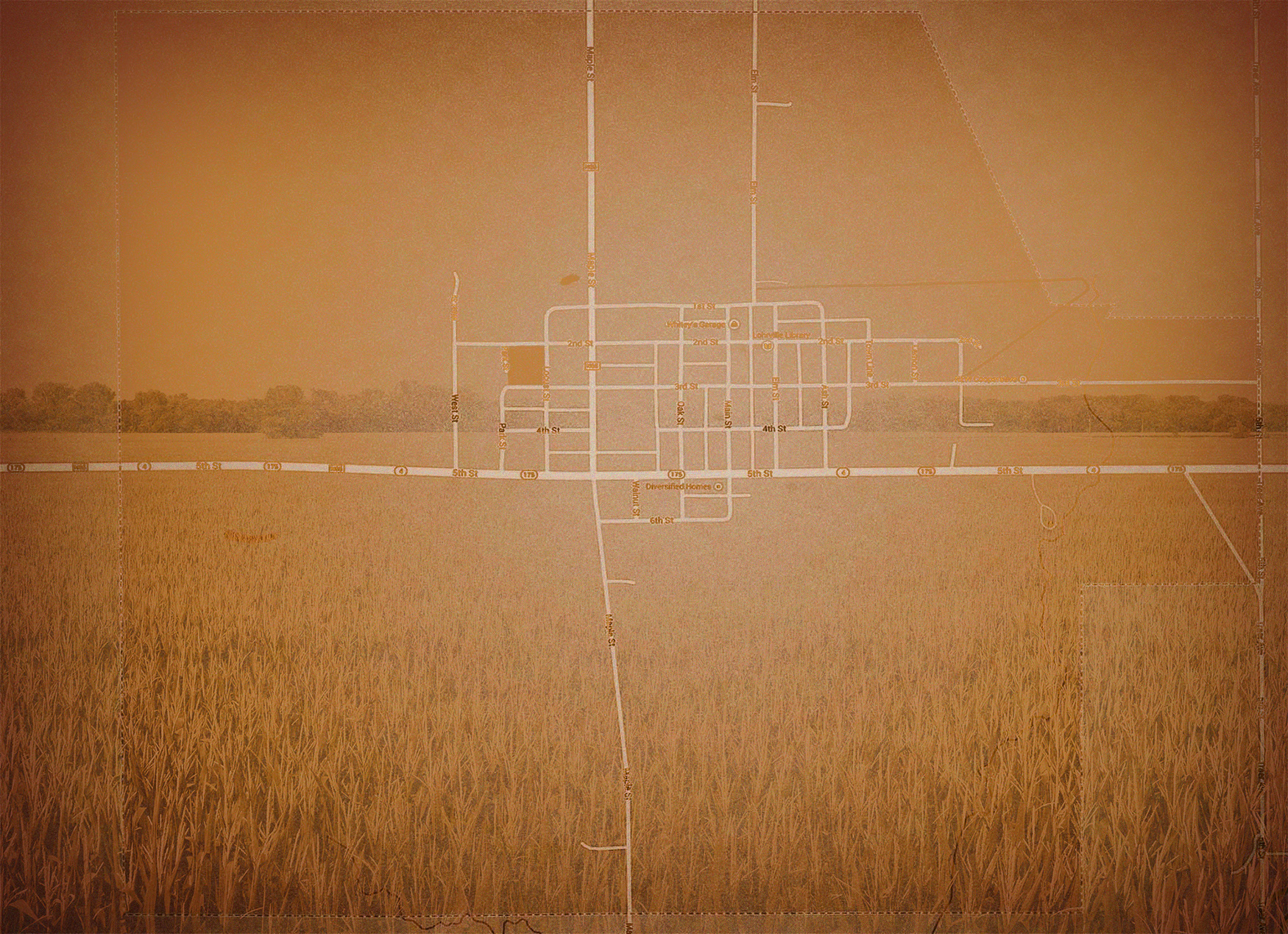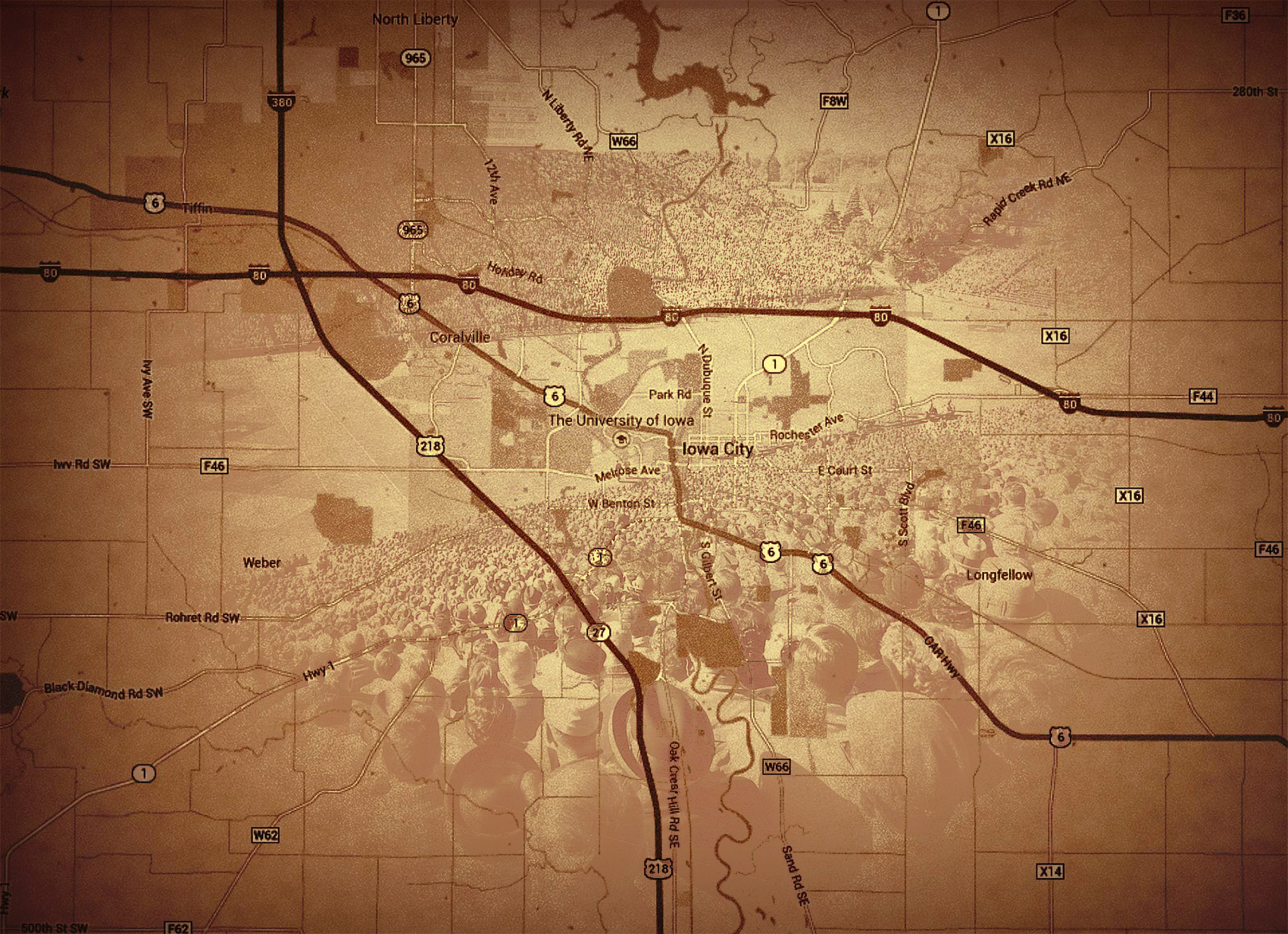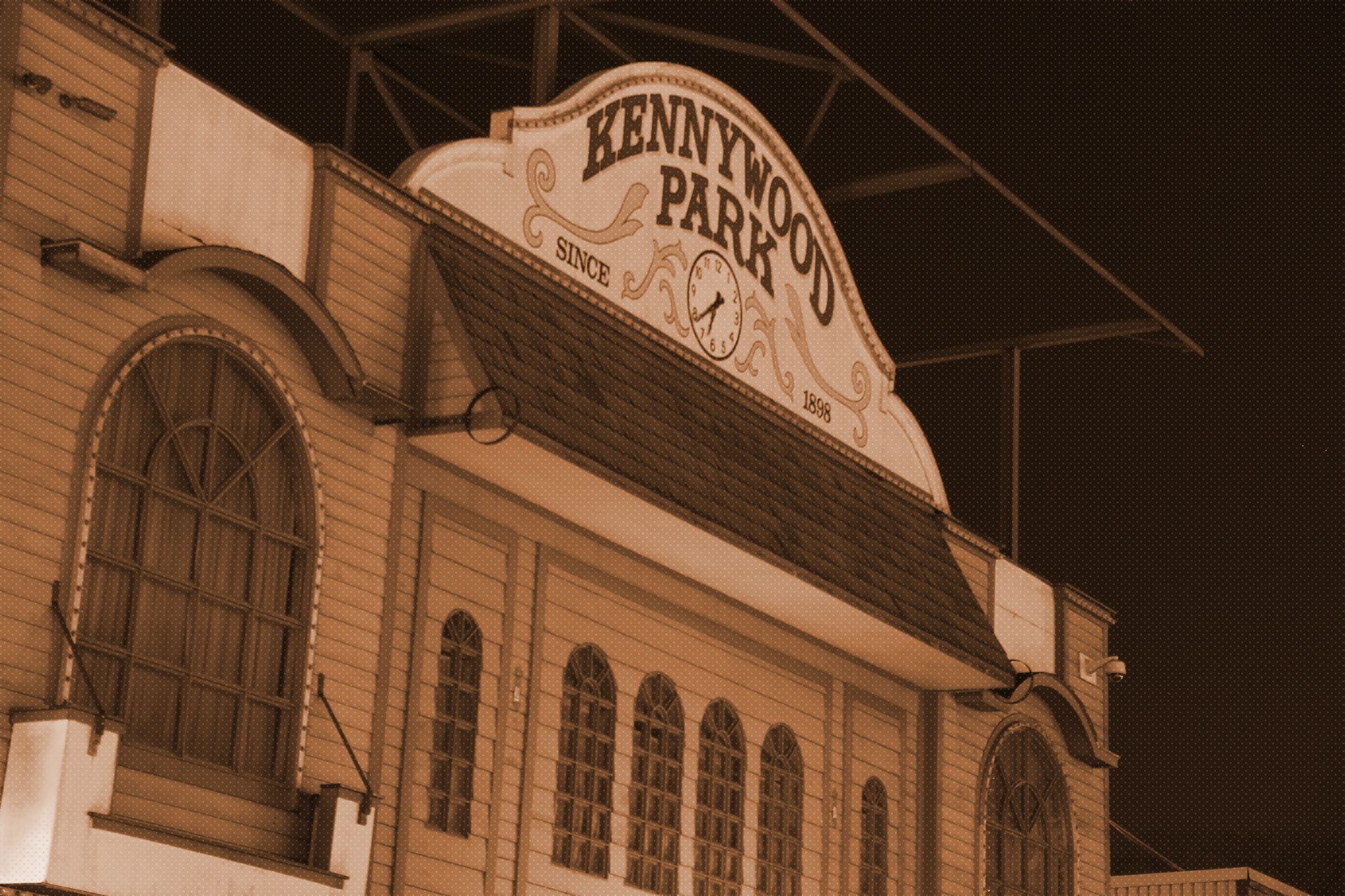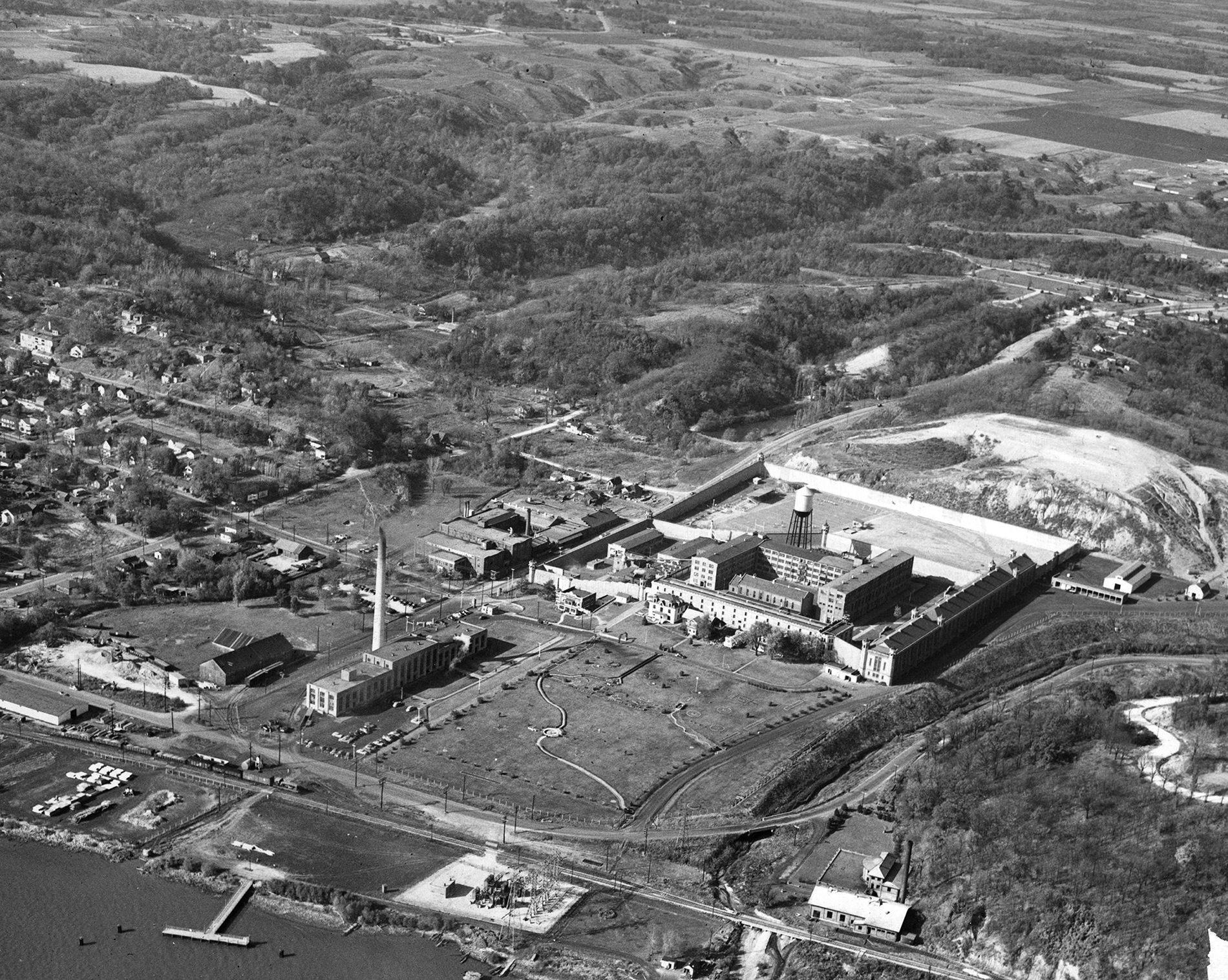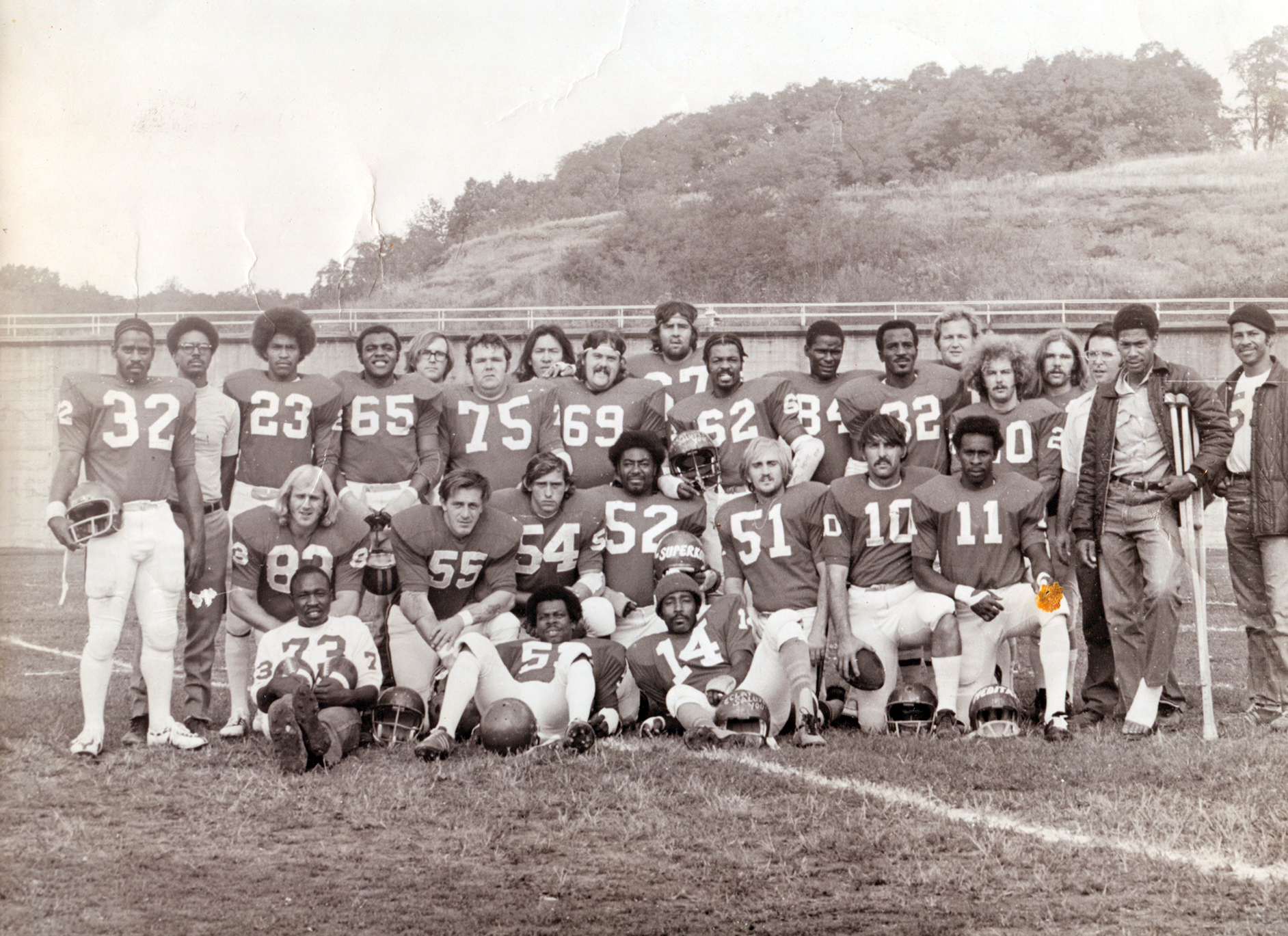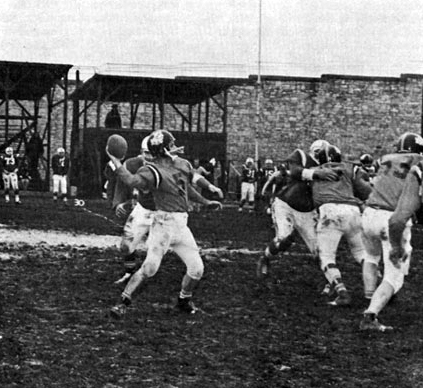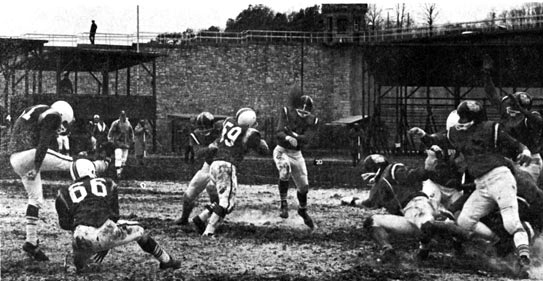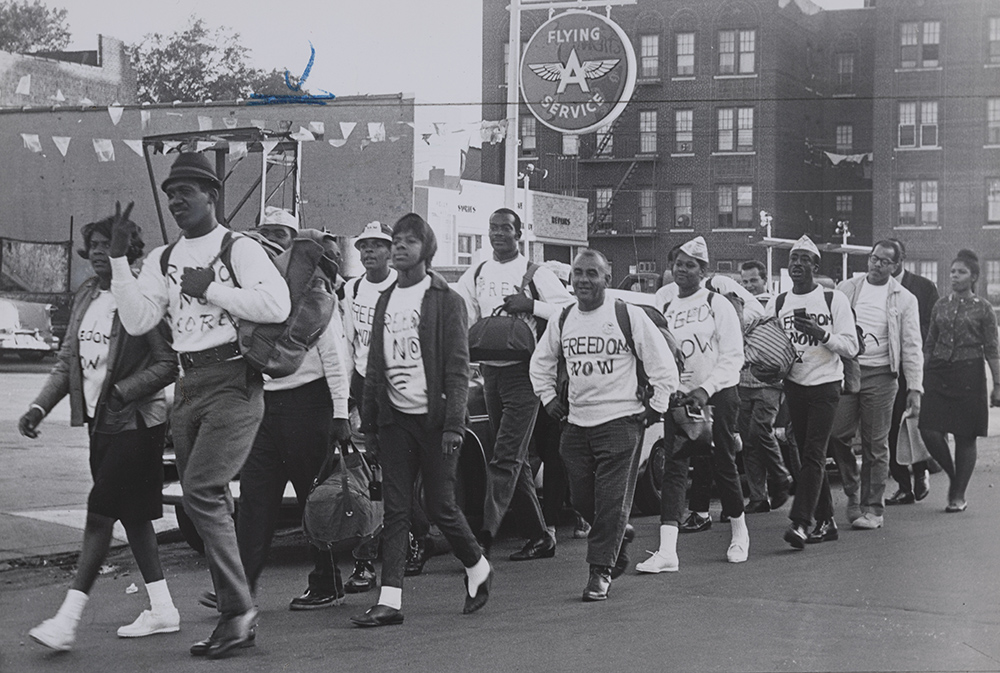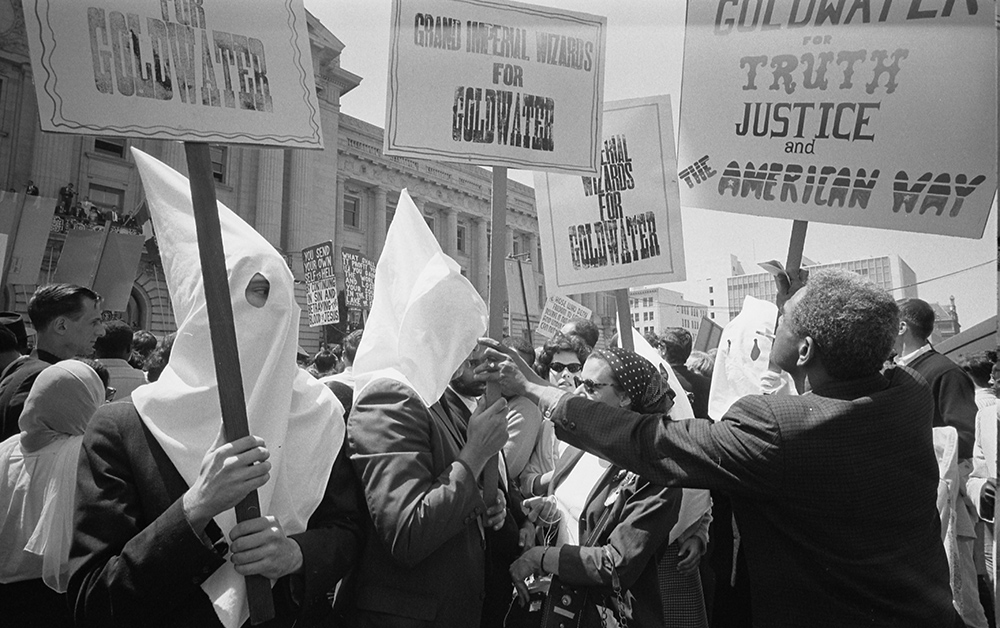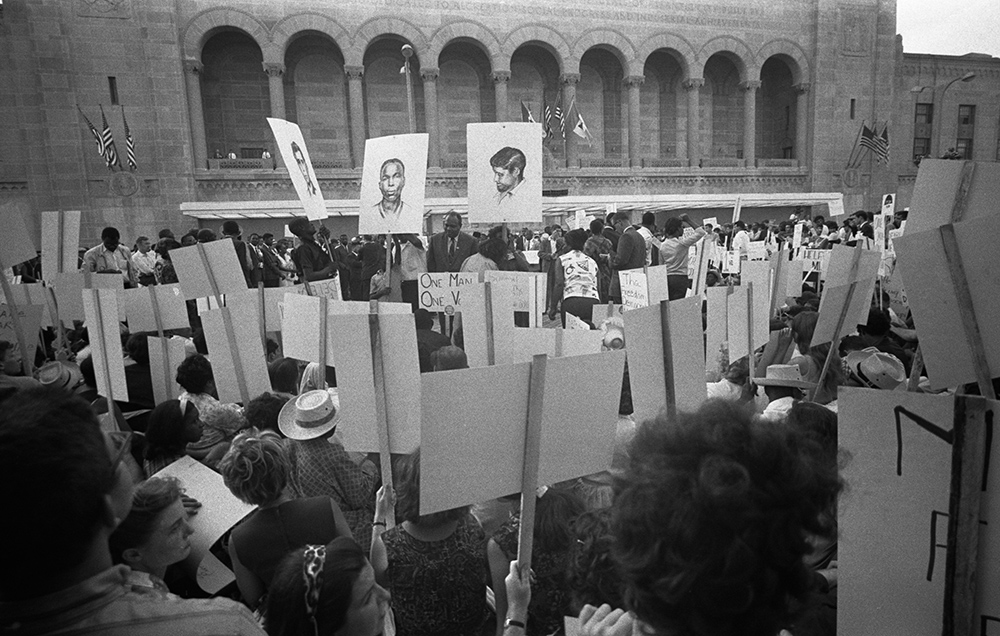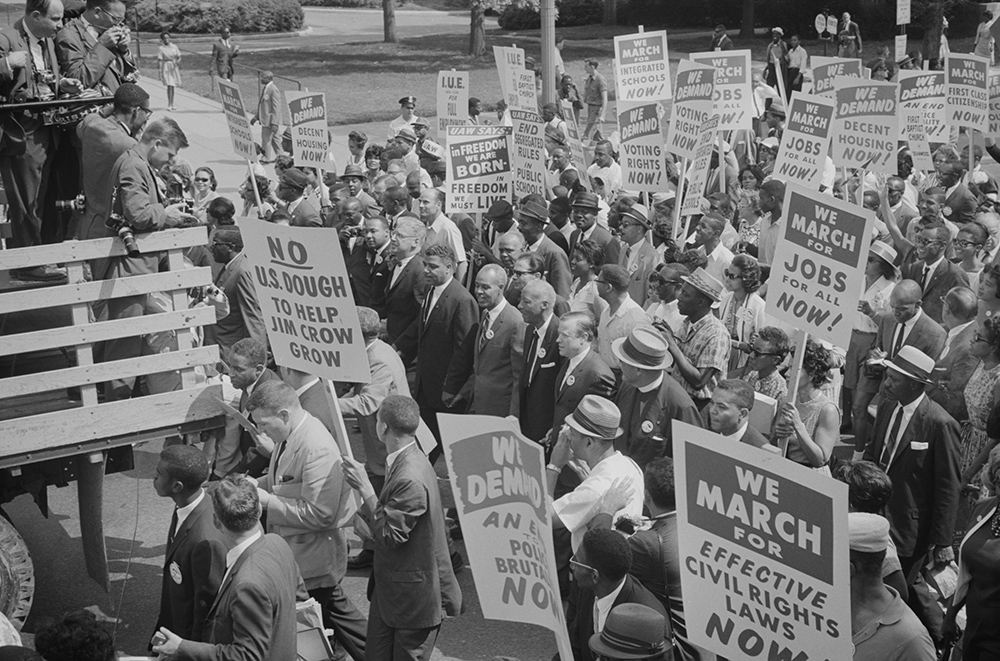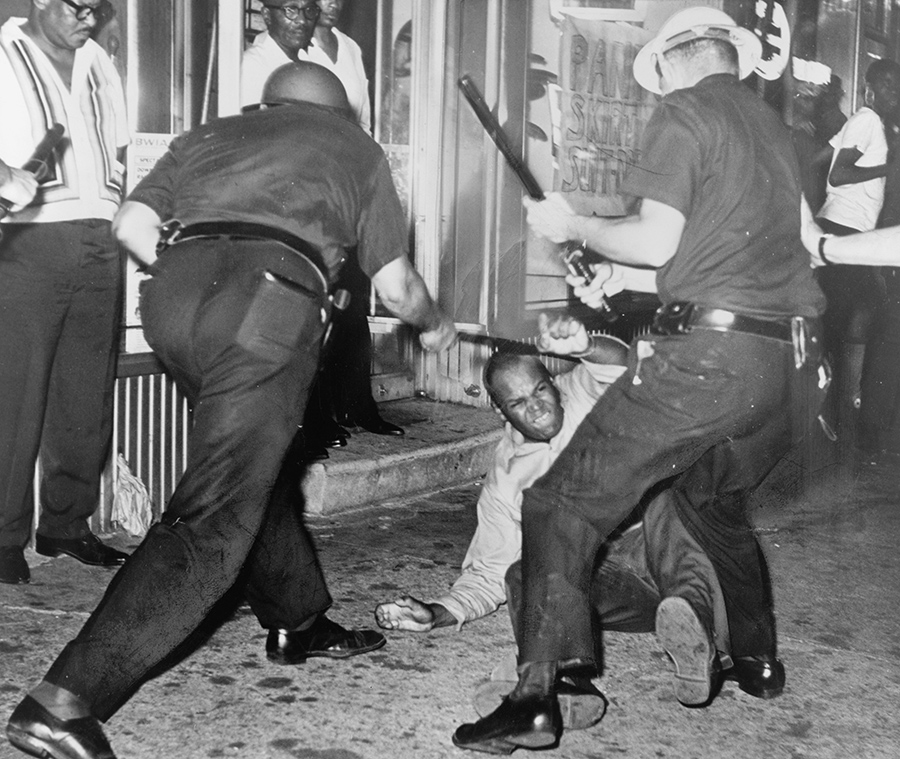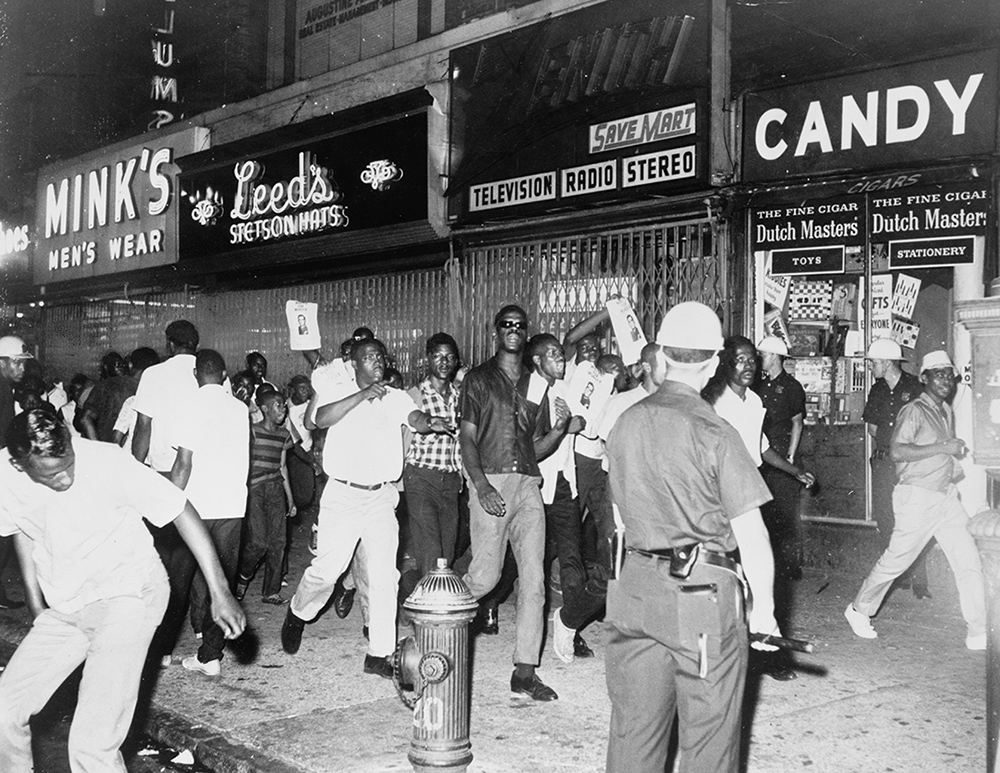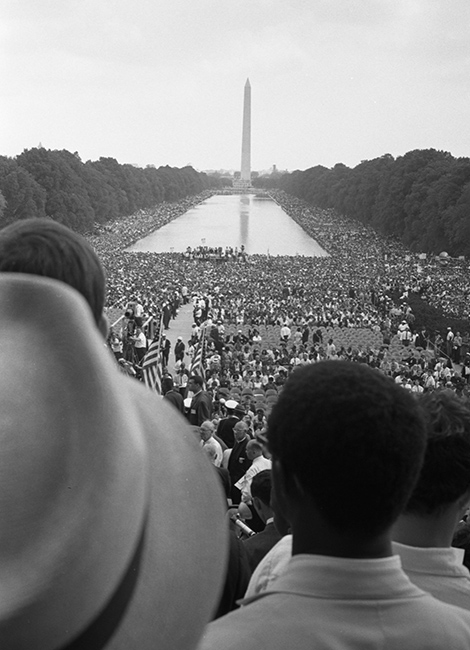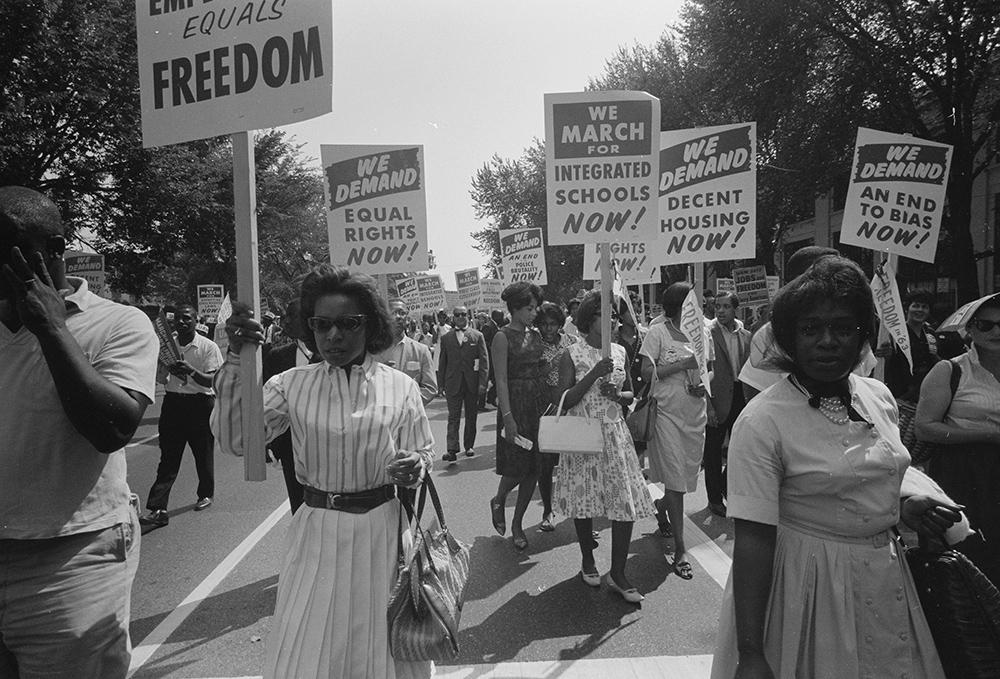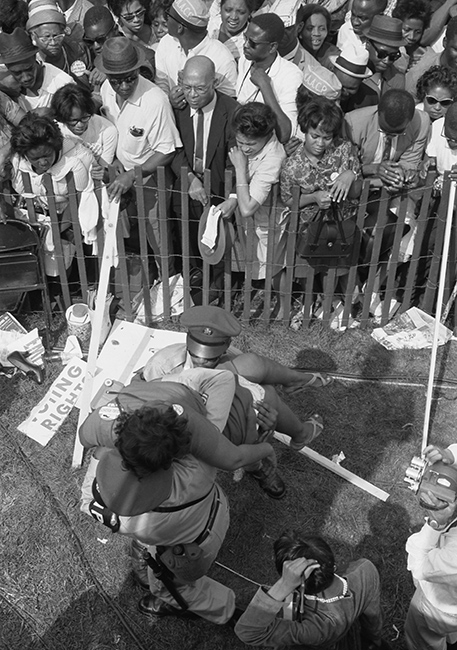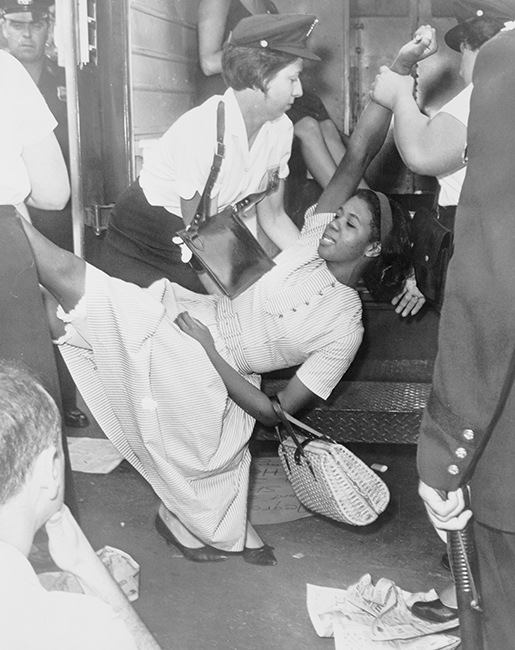Above: Clipping from The Daily Iowan, August 11, 1964.
Bobby Washington, 27, knew exactly what he was doing when he returned to his Iowa City apartment, rummaged through his roommate's nightstand, and found the .25-caliber gun. He knew exactly what he was doing when he took the gun to Wilson's Sporting Goods, two blocks away, and paid $10 to buy a clip of bullets. And he knew exactly what he was doing when he went to the local Union Hall with the loaded pistol.
He was going to shoot John Cavanaugh dead.
On that Saturday morning 50 years ago this past August, after working the swing shift at the local Procter & Gamble plant, inspecting Gleem toothpaste tubes and screwing on the caps, Washington and a buddy had gone to the Union Hall. Cavanaugh, a 34-year-old ex-Marine, glanced over at Washington and cracked:
“Boy, what’re you doin’ here?”
Washington ignored the comment, but Cavanaugh repeated it.
“I can go anywhere I wanna go,” Washington replied.
A scuffle ensued; Washington’s white T-shirt got ripped. Onlookers broke up the fight.

A newspaper clipping shows the sign on the front of the long-since closed Li'l Bill's. Image courtesy of The Daily Iowan
On his way home, Washington stopped at the apartment, picked up the gun and returned to the Union Hall. But Cavanaugh was no longer there, so he went to Li'l Bill's, a pizza parlor and tavern on the ground floor of Washington’s walk-up apartment. He took a seat at the bar and ordered a draft beer. While waiting, Washington felt a paw of a hand on his shoulder, which spun him around on the barstool.
It was Cavanaugh. “Heard you were lookin’ for me,” he said.
Red, the bartender, sensing trouble, took Cavanaugh by the arm and tried to lead him out the door. Cavanaugh turned back to Washington and bellowed, “I’ll kill you.”
At that instant, Washington took the gun from his pocket and shot Cavanaugh four times in the chest and neck.
Washington laid the pistol down on the bar and said, “Hey Red, gimme that beer.”
For better or worse, Iowa was—and is—a social laboratory for the rest of America. That’s what the Iowa Presidential Caucuses are supposed to be about every four years. Iowa is thought to be the home to Main Street opinion and values. Iowa’s remoteness and insularity means it’s not as driven by the energy, fickleness, and vivacity of urban America. Iowa finds itself immune from the intensity of New York, California, or Florida. The state is modest and middle-class, not many rich people and not many poor. Rural Iowa still brims with farmers in Carhartt overalls driving tractors downtown; tuna or Tater Tot casseroles when someone dies. If you haven’t hit a deer with your pickup, you know someone who has. The state is where John Wayne came from, both literally and mythically. Linguists refer to phonetic patterns used in Iowa as General American or Midwestern Standard, a benchmark so clear and understandable that newscasters are taught to mimic Iowa articulation. Iowa nahce still reigns, where children are taught to say please and thank you. Iowa, after all, is everyman’s America.
Or perhaps more accurately, everyman’s white America.
To understand the deadly encounter between Bobby Washington and John Cavanaugh is to understand where we once were and where we are today as Americans.
And maybe because of the state’s real-versus-idealized identity, Iowa City—home to the University of Iowa, demarcated by three-exit dots on Interstate 80, the 3,000-mile Main Street that connects New York to California—may well be a bellwether of both our nation’s noblest attributes and our darkest underbelly.
Today, not many outside a few diehard Hawkeye basketball fans and old-timers, might recognize the names Robert Lee Washington or John William Cavanaugh. The ordinariness of a run-of-the-mill bar shooting in Middle America that happened 50 years ago is not something our celebrity-saturated media are much interested in. This isn't one of those perennial favorites about a man imprisoned for decades for a crime he didn't commit. Two men—one black, the other white— a half-century ago got into a fight and one died. Such events happen every day.
To detail two very different childhoods, adolescences, and achingly painful trajectories to manhood, followed by the death of one and the redemption of the other, though, is to discover something profound and archetypal about growing up in America.
Those four gunshots that ended Cavanaugh’s life were not heard around the world, but the murder, context and aftermath are universal. The killing of John Cavanaugh in Iowa City on a sweltering August afternoon in 1964 reflects a flashpoint on the continuum of race relations in America. Two opposing homegrown cultures violently clashed, as Americans lived through a fundamental and visceral shift in history. The murder is a prism through which we can view the uneasy truce between blacks and whites. The story behind the charged confrontation reminds us of how fractured this nation was—and how fractured it remains. To understand the deadly encounter between Bobby Washington and John Cavanaugh is to understand where we once were and where we are today as Americans.
Lohrville
Iowa
Born in the tiny, fertile north-central Iowa town of Elma in 1930, John William Cavanaugh, the fourth of seven brothers and sisters, graduated high school in Lohrville. None of the graduating class had ever seen, much less talked to, a black person. Lohrville (pronounced Laura-ville) still doesn’t have a traffic light, just a four-way stop sign next to the elementary school. The only elevator in town raises and lowers grain, not people. The town’s centerpiece is a water tower, with L-O-H-R-V-I-L-L-E stenciled in big black block letters. From that tower every family gets water for drinking, bathing, cooking and gardening. Almost everyone in Lohrville is a farmer, and if you aren’t a farmer, you work in a business that services farmers. Iowans being Iowans, when you drive your pickup, along with a slight nod, you raise an index finger from your steering wheel to bid hello. It’s called the “Iowa Wave” because you do it to everyone who passes; since few strangers venture in these parts of Iowa. Most of the town’s population of 368 wears their Irish heritage proudly. Lohrville’s biggest event is the annual corned beef and cabbage dinner that everyone attends at the Community Building, right after the St. Patrick’s Day Parade (“The world’s shortest parade,” is how Mayor Donny Hobbs puts it). Lohrville’s motto is, “Better not Bigger.”
Corn grows on all four sides of Lohrville; in fact it grows so fast and so tall that you can hear it growing, pop-pop-popping, especially in the early morning hours. The rows and rows form an exacting geometric maze. To Lohrville kids, the fields go forever.
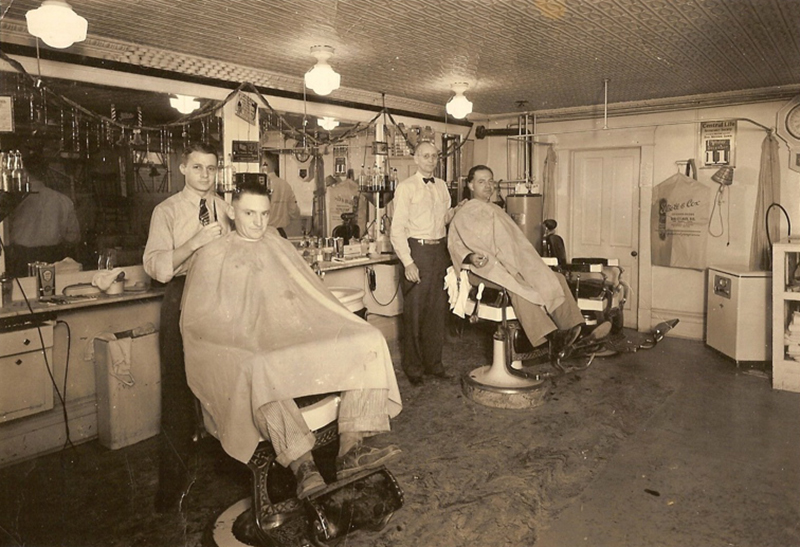
A barbershop in Lohrville in the 1950s.
A little more than two square miles, Lohrville was founded in 1881 with the laying of the Illinois Central Railroad tracks on land owned by Jacob A. and Mary E. Lohr. Particularly in the 1940s, few folks from Lohrville set foot—for too long, that is—outside of rural Calhoun, Greene, Carroll, Webster, or Sac counties. Lohrville was a deep pocket of fecund earth hard to climb out of, even if you wanted to. You were born there, and, if you were like everyone else, you likely died there. You married a Calhoun County girl or boy, had a brood of kids, worked your grandfather’s, then your father’s, then your, farm. Big, blustery Omaha, 130 miles away, might well have been the moon. The most popular excursion out of the county would be to Des Moines to marvel at the butter cow at the Iowa State Fair. That, along with a stroll down the midway, Icy in one hand, cotton-candy beehive in the other. Cities like Chicago, Los Angeles, and Miami were tucked away in atlases; Lohrville kids didn’t have much reason to consider these foreign-postcard destinations. Rural Iowa was a cocoon of parents, brothers, sisters, grandparents, aunts, uncles, cousins, nieces and nephews. If you weren’t related by blood, chances weren’t slim you were by marriage. You could tell who was tooling down Maple Street just by the sound of a vehicle’s engine.
Don’t go making life alongside these washboard, gravel roads simple, pure and carefree. Growing up in Lohrville wasn’t easy, particularly if you were a Cavanaugh. Gertrude and Francis Mark Cavanaugh had eight children. There were Mary, Helen, Jerome, John (as a child, he was known as Billy), Joseph, Bernadine, and Charlotte; the Cavanaughs’ firstborn died from what at the time was called “crib death.” Every day without fail, Billy Cavanaugh’s father ate three eggs and six strips of bacon. He leased the land he labored, each season hoping there’d be just the right combination of sun and rain to squeeze enough profit from the corn and soybeans he grew and the cattle and pigs he raised. Francis Mark’s wife, Gertrude, died of a perforated uterus when she was 40. Francis, who to everyone was just Mark, never remarried. That left Billy, who was eight at the time, to be raised by his two older sisters, Mary and Helen.
When Billy graduated from Lohrville Community High School in 1947, he had accumulated a lackluster 1.7 GPA, somewhere between a D and a C. Cavanaugh graduated 21st in a class of 31. But that wasn’t going to stop him. A strapping, barrel-chested young man, Billy was ripe for adventure. He stayed in Lohrville to help his father work the land, but within two years he had had enough of farm life. Cavanaugh had the foolhardy smarts to look around the corner and see what to almost everyone else in town was too risky, too large. He wanted more. He punched the traditional ticket, the armed forces; Billy Cavanaugh chose to enlist in the United States Marine Corps.
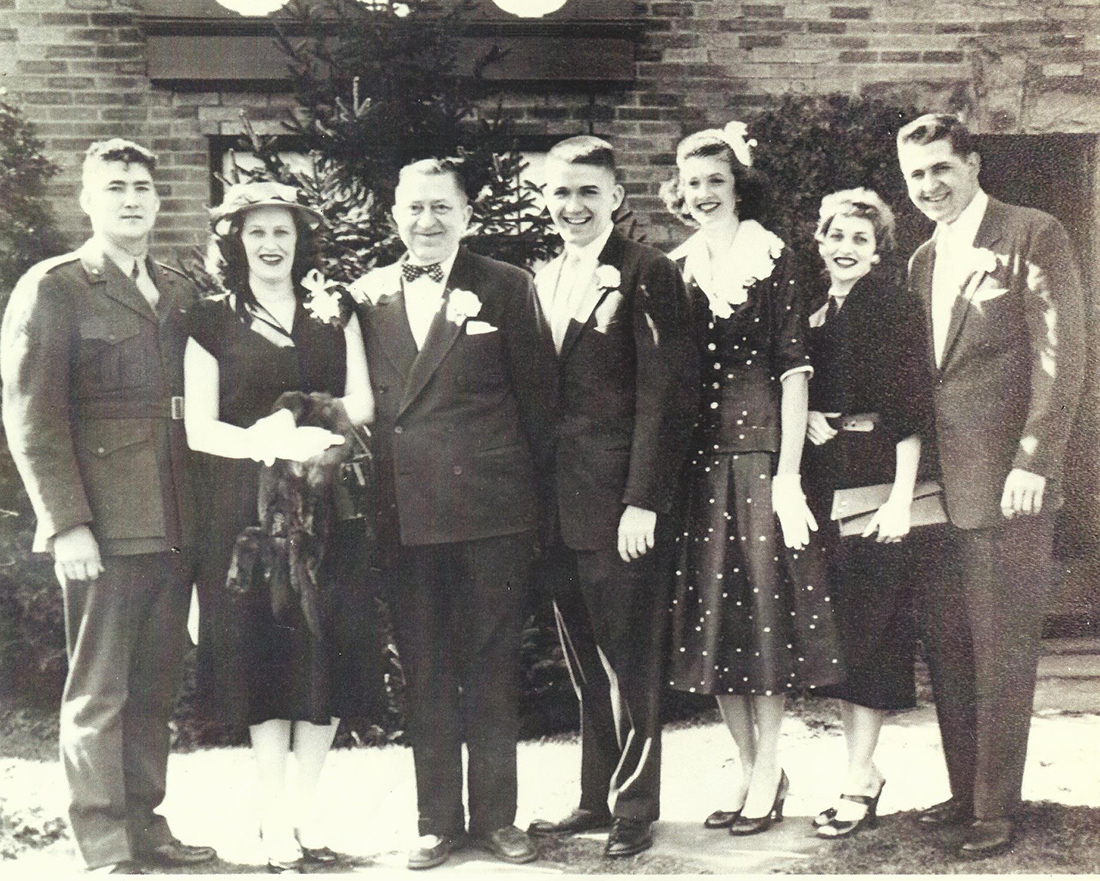
From left to right: John Cavanaugh, Nancy Sebring Cavanaugh, Walt Sebring Sr. (Nancy's father), Bob Sebring (Nancy’s brother), Mary Sebring Kane (Nancy’s sister), Marilyn Sebring (Nancy’s sister-in-law) and Walt Sebring Jr. (Nancy’s brother), taken in Mount Lebanon, Pa.
Cavanaugh got himself to the recruiting station in Des Moines in July, 1949, went through basic training at Camp Pendleton in San Diego and shipped out in 1951 to Korea, where he was based in the port city of Masan. He was a corporal at that point and served overseas eight months. He returned to Quantico, Virginia, where he was promoted to Sergeant, then Staff Sergeant. Then he was transferred to Pittsburgh, where he became a Marine recruiter for eight months, then platooned to the Marine base at Parris Island, South Carolina. There something happened. He was busted in rank back to Sergeant for an unspecified reason, according to his Record of Service. Cavanaugh spent the rest of his military service at the Great Lakes Naval Station in the mailroom. He was discharged in July 1958. In Marine terms, Cavanaugh would be known as a pogue, a non-combat leatherneck tasked with administrative duties.
It was in Pittsburgh where he met a striking, dark-haired woman who had graduated from nearby Mount Lebanon High School and Ohio State University with a degree in journalism. Nancy Sebring first went to Bethany College, a liberal arts college in the West Virginia panhandle before transferring to Ohio State (where she was society editor of the college newspaper, The Lantern). By all accounts, she was feisty, opinionated, smart, and determined. Nancy was working in her father’s bookkeeping office when she noticed a handsome, broad-shouldered Marine working in the same complex. Cavanaugh had hazel eyes and the beginnings of gray-flecked hair. Theirs was a whirlwind romance; they had known each other for three weeks before they got married on May 29, 1954. Nancy was 30 and Cavanaugh was 23. Nancy’s friends placed bets on how long the marriage would last.
Within a year, Cavanaugh was transferred to the Naval Station near Waukegan, Illinois, where the couple’s first child was born; that child, Jeffrey, choked to death when he was six months old. Two more children, Kevin and Karen, followed, and when the couple moved to Iowa, they had two more children, Kelly and Kathy. In Iowa City, they rented a two-story house on the south side of the university campus, on East Prentiss Street. With the G.I. Bill paying his tuition, Cavanaugh enrolled in the State University of Iowa, as it was called then. (It’s unclear how he was accepted with such a poor high school record.) His wife already had a college degree, and he too would try to earn one. Meanwhile, Nancy enrolled as a master’s student in the College of Education. With four children, it’d be a juggling act.
To rural Iowans, Iowa City (then as it is now) was exotic, liberal and permissive, a college town with a Chinese restaurant or two and a bookstore. People said Iowa City was a free-spirited kind of place. Fresh out of the Marines, Cavanaugh was set on finding out first-hand.
His first class was Art 24:105—sketching nude models. Sit in a classroom with a parade of nude girls posing up front. Cavanaugh would sketch them, or at least pretend to sketch them. Could it get any better than that?
Cavanaugh got a B in the class, the highest grade he ever was to receive. That first year, he was placed on academic probation, receiving D’s in chemistry, American government, and general zoology. In the fall semester of 1963, he was admitted on probation to the College of Business Administration, but dropped out by December. With four young children at home, Cavanaugh didn’t have much time to study. Or perhaps there were just too many distractions in Iowa City. Maybe it all had been too much, going from Lohrville to the Marines to what Iowans call with no small amount of pride the Athens of the Midwest.
Whatever it was, to those who knew him in those years, Cavanaugh had undergone a transformation of sorts. To his younger brother, Joe, Cavanaugh had come back a changed man. Joe didn’t know whether it was the Marines, Korea, being married and a father, or losing his firstborn son. Maybe it was just a phase he was going through. Money had to be an issue. Joe didn’t know exactly why, but Cavanaugh seemed to drink more, had an attitude, and had become a hothead. He no longer was Billy, but had come back from the Marines with a nickname, Big John. Joe Cavanaugh said John had turned “vulgar and crude.” Those were the words he used.
Robert Lee Washington was born in 1937 in Sasser, Georgia, 105 miles southwest of Macon, in as rural an outpost of America as where John Cavanaugh had been born eight years earlier. Washington’s father, Drellie, was a laborer and occasional barber; his mother, Annie, to use the term of the era, was a homemaker. During the summer, Drellie and Annie left Bobby with a maternal aunt while the couple caravanned south to Belle Glade, where Drellie hired himself out, cutting sugarcane in the hot, humid fields of Florida with a scythe. Belle Glade, then and now, was known as Muck City, a swampland that produces more than half the nation’s sugarcane.
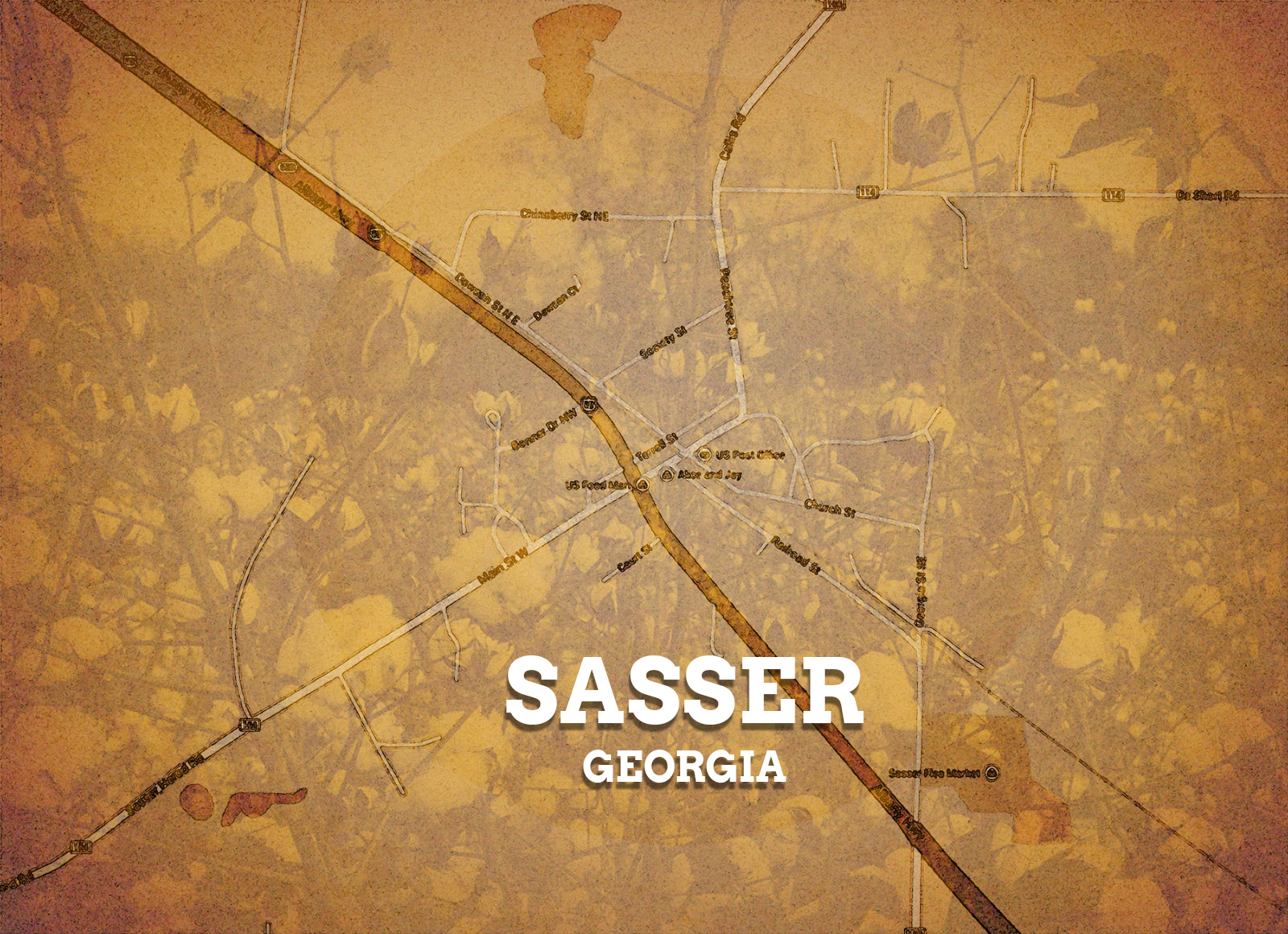
When Bobby was three, the family pulled up stakes, hopscotched north to Newark, New Jersey, then westward to Rockford, Illinois, during the job boom that World War II had created. Drellie went first, Bobby and his mother followed six months later, boarding the “colored car” of the Union Pacific at Newark’s Pennsylvania Station. Annie, the youngest of seven, had sisters who’d already migrated from Sasser to Rockford, so when Bobby and his mother pulled into the train depot just south of Main and Mill streets, the Washington family had a grand reunion. At the time, factory jobs were plentiful in gritty Rockford, known as the screw capital of the world. Drellie had found work on the assembly line at Gunite Foundries, manufacturing wheels for armored tanks. Annie took a job as a laundress at a nursing home.
Drellie and Annie Washington rented an upstairs apartment on Island Avenue. Then they moved to an apartment on Edward Street, and finally in 1945, to Winnebago Street, across the street from Tinker Park. It was the first house the Washingtons ever bought and it cost $5,500. Bobby slept in one bedroom; his maternal grandmother, Minnie Lee Howard, slept in the other; and his parents slept on a rollaway in the living room. During the evenings, Mrs. Howard and Bobby took turns reading to each other at the kitchen table.
The Washingtons bought the house from an Italian couple who had planted cherry and plum trees in the backyard, along with a small vineyard of grapes. In the basement on weekends, Drellie set up a barber’s chair, poured his friends glasses of home-fermented wine, and gave haircuts to anyone who wanted one. Drellie Washington’s makeshift barbershop was the place to get your head buzzed. That is, if you were black it was.
Tinker Park is where Bobby gravitated—a home across the street from home. A neighborhood park where black kids played hoops every summer afternoon till the sun dipped below the hazy industrial horizon when night descended along with an army of mosquitos.
And that’s really where this story begins.
Rockford
Illinois
As an agile junior high school basketball player, Washington, along with his teammates, organized a raffle to buy uniforms; midway through the season they got them: snazzy blue satin shorts and white ribbed jersey tops with blue numbers. The uniforms must have boosted the team’s confidence as well as the soaring abilities of its players. As sixth graders, Washington’s team posted a 27-0 record to became Rockford Boys Club champs.
Like teenage boys everywhere, Washington looked at sports as the way to win recognition; for Washington, this singular gauge of achievement played mightily to his natural strengths. Once, his basketball coach challenged the neighborhood boys to beat him at ping-pong, and pint-sized Washington handed a surprised coach his first-ever defeat. Washington wasn’t large or muscular, but that made him work harder, think faster, get to the right place at the right time before his opponents realized he had already arrived.
In 1954, when Washington was 16, his girlfriend, Shirley, got pregnant and had a baby they named Regina. There was no talk of abortion or adoption. Shirley and Bobby’s parents would care for the child.
That he was a father didn’t deter Washington from shining. At Rockford West High, Washington made the varsity basketball team as a junior, joining what everyone in town would call the Fabulous Five Warriors. The Warriors became legendary. They still are. So was their likeable coach, Alex Saudargas. Fans would stand throughout entire games and chant “Alex, Alex, Alex!” Before winning the Illinois state championship downstate in 1955, Rockford West hadn’t won a state title in 38 years. If that hadn’t been big enough, the Warriors scored an unbelievable six points in one second in the championship game. Rockford old-timers still shake their heads when they talk about that one.
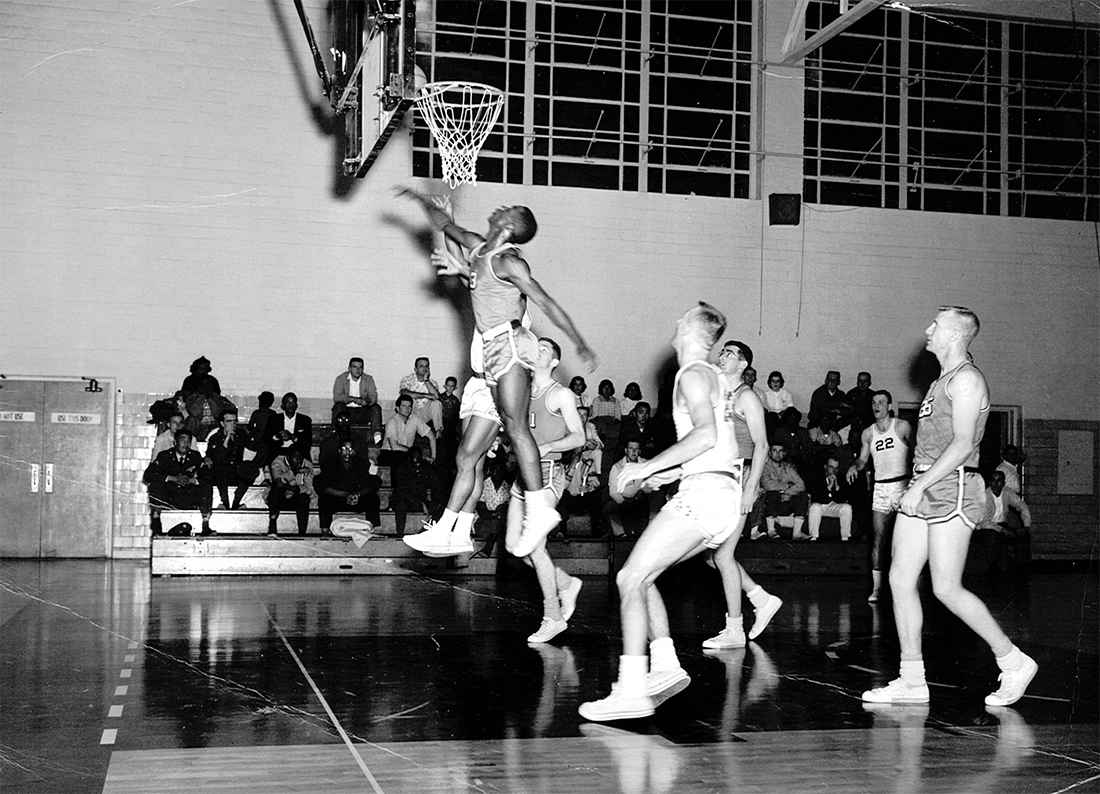
Washington playing against cross-town rival, Rockford East High School, 1956.
In the state championship final matchup in 1956, the Edwardsville Intelligencer wrote: “Defending champion Rockford West retained their hoop supremacy by tiptoeing past the Bengals, 67-65, in a thrill-a-second classic that is not likely to be quickly forgotten. The Red and Black of Rockford West were paced by the unexpected but brilliant shooting of Bobby Washington. ... Coach Saudargas said, ‘We owe our margin of victory to Washington; he was our key performer. Without him we’d never won.’”
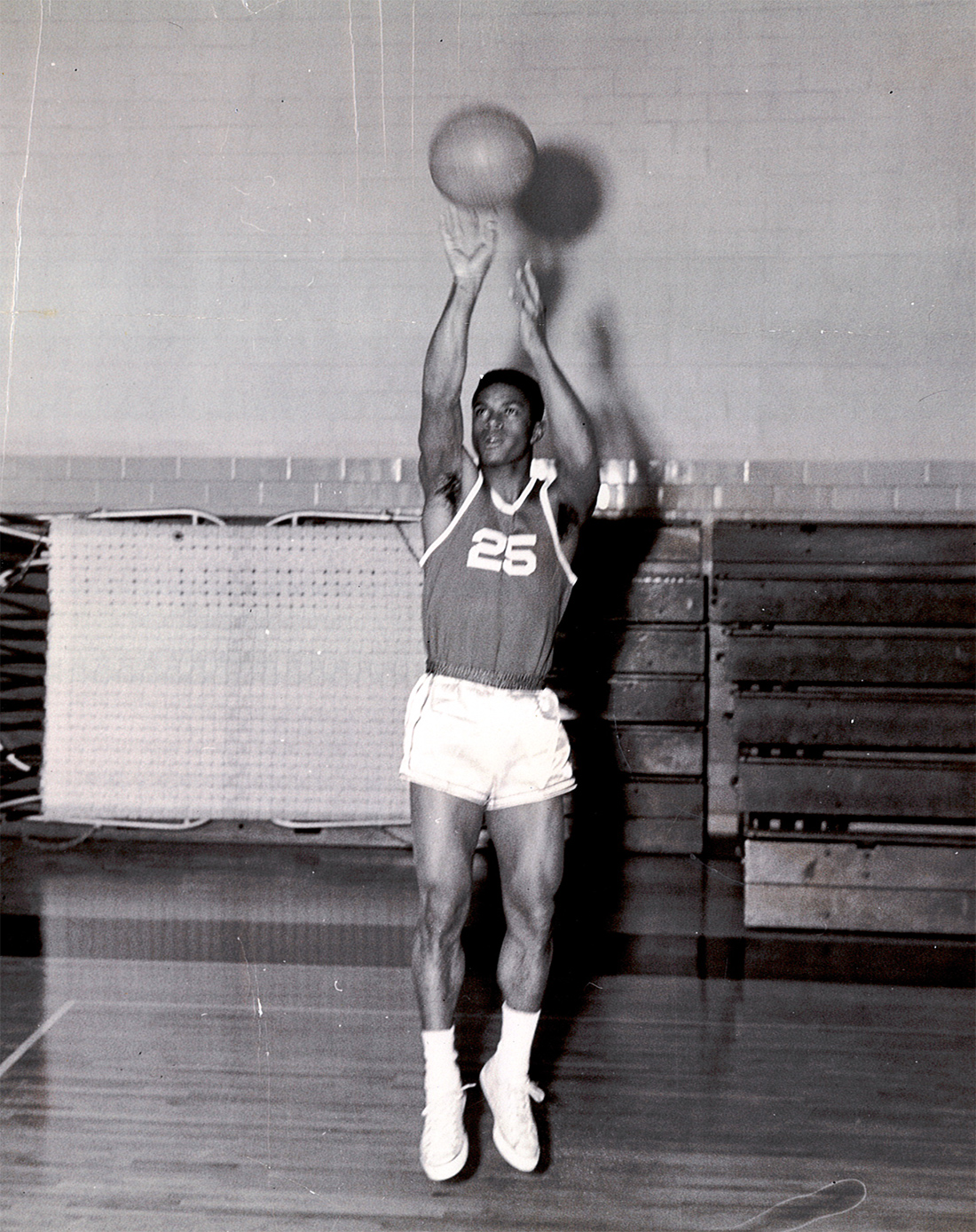
Washington practicing for the US Army Basketball Team, Fort Bliss, Texas, 1962.
Not only did Washington excel at basketball, he also was Rockford West’s quarterback and the baseball team’s star pitcher. His fastball moved, and when he hurled a curveball, the ball would drop as though it had rolled off the edge of a table. Washington led the Red and Black to the Rock River Valley League championship twice. His batting average was .385, not bad for a pitcher. The Cubs, Twins, Braves, and Yankees sent scouts to Rockford to sign Washington to their minor league teams. Despite doing spectacularly well in all three sports, though, it was basketball that led to recruitment trips to Indiana University and the University of Iowa. Washington wanted to get an education first, then make money playing ball. At least, that was the plan.
Ultimately, though, he chose basketball and baseball at Iowa. Washington got a full-ride basketball scholarship. It’d be basketball in winter and baseball in the spring. Truth is Washington probably was better suited for baseball, but he was more comfortable playing basketball because there were black players on the Iowa team. At that time, 1956, no black player had ever played varsity basketball for the University of Illinois. Iowa picked up two other African-American players from the Rockford West state championship team along with Bobby.
Like South Bend or Ann Arbor, Iowa City is one of America’s great college sports towns. No Major League professional teams call Iowa home and because of that, college sports reign supreme. And although some Iowa State Cyclones fans may quibble the point, Iowa City is the epicenter for collegiate athletics in the state. Thousands of boisterous, jostling, beer-guzzling fans pack Iowa City taverns before, during and after Hawkeye football, basketball games, and—this being Iowa—wrestling matches. Elaborate tailgating has become an essential Iowa experience, which, depending on your point of view, can be one of life’s greatest moments or a citywide binge of beer, brats and not unoccasional brawls.
Adept Washington certainly came equipped to fly at Iowa. Recruited by basketball legend Coach Bucky O’Conner, Washington joined the elite Iowa team that three years earlier had lost in the NCAA Final Four to University of San Francisco and Bill Russell, who scored 26 points and grabbed 27 rebounds in a single game, a record that stands today. Along with gangling, six-foot, seven-inch Nolden Gentry Jr. and Don Slaughter, the trio from championship Rockford West, all on scholarships at Iowa, played together as freshmen and sophomores. After Coach O’Conner was killed in a freak car accident in 1958, Washington, Gentry and Slaughter played on the starting five for Sharm Scheuerman, at 24, the youngest-ever coach in Division I basketball.
At five-feet, nine-inches, impossibly short for a basketball player now, Washington made up for his stature with that uncanny sense of knowing where he was, where his opponents expected him to be, and how to exploit the difference. Washington was in perpetual motion, always aware, never stuck where the other team thought he’d be.
As soon as basketball season ended, Washington moved from the University Field House to the Hawkeye baseball diamond, where he started on the freshman team at third base. Washington was so versatile that at the end of his freshman year Iowa Coach Otto Vogel had hatched a plan: convert him to a catcher. Bobby would go from third base to catcher. It was a done deal. Maybe Coach had been inspired by the Dodgers’ great black catcher, Roy Campanella.
But Washington didn’t want anything to do with Coach Vogel’s switcheroo. Crouching for nine innings? Wearing all that equipment? Washington was too exhausted from basketball season to be kneeling behind home plate every day. Coach was adamant about the makeover. There was no convincing Vogel, and Washington kissed off baseball.
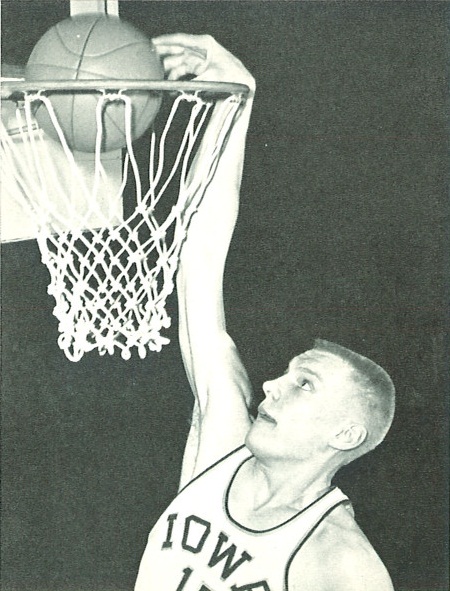
Don Nelson, 1962 Hawkeye (University of Iowa yearbook)
Which suited him fine. He could concentrate on basketball fulltime. He, Gentry and Slaughter had made history together at Rockford West. And by all accounts at the time, Washington’s decision was the right one. As point guard in the 1958 season, Washington was the basketball team’s brains, playing with a calm and precision. He was helped by the talented forward Don Nelson, whose trademark became a one-handed foul shot. Nelson would eventually steal the limelight everywhere he went, playing for the Boston Celtics, and coaching for the Milwaukee Bucks, Golden State Warriors, and New York Knicks.
Life was good. Washington roomed at Hillcrest Residence Hall on the west side of campus for the first three years; that’s where the university’s basketball and football players lived. The few black students at Iowa who were not athletes on scholarships customarily lived in rooming houses run by black women in town. During their senior years, Washington and Gentry shared a basement apartment two blocks from cavernous Kinnick Stadium, where the Hawkeyes played under Coach Forest Evashevski. In exchange for rent, all Washington and Gentry had to do was rake leaves, shovel snow, and mow the grass. It was a sweet deal. The Big Ten Conference was arguably the fiercest athletic conference in America, and Iowa at the time was a perennial contender. Winning was what was on everyone’s mind. What was good for Hawkeye sports was good for Iowa, maybe even for America.
Off the court, Washington enrolled in a host of humanities classes, unusual for a college athlete. He didn’t opt for the Mickey Mouse courses most players then and now are counseled to take. Washington signed up for History of Ideas, Elementary Ethics, Ancient and Modern Literature, Introduction to Philosophy, American Philosophy, American Government.
Of all of his courses, Washington enjoyed philosophy the most. He took particular interest in the seventeenth-century French philosopher, René Descartes, the father of rationalism, known for provisional moralism, Cartesianism, and the concept of the duality of mind and body, whether the two operate jointly or independently. Descartes wrote about deducing knowledge not from speculation, religion, or emotion, but from hard evidence and reason. It was a notion that not only underscored who Washington was at the time, but who he would become.
He took to hanging out at Kinney’s, a popular bar, where he’d talk about philosophy, politics, books, sex, and blacks and whites in America. If Jack Kerouac and Neal Cassady ever were to have stopped in at Kinney’s on any of their manic cross-country road trips, they would have felt right at home.
Once at Kinney’s, one of Washington’s girlfriends asked him what he wanted to do with his life.
Washington thought for a couple of seconds, then replied: “Be a philosopher.”
Washington would hold court at Kinney’s, rubbing shoulders with girls, fans, boosters, even a few grad students who actually had something to talk to him about. Washington could pack any bar just with word that he might show up. He was a tavern owner’s dream. He never had to buy a drink. No one would let him.
By the time Washington would look up at the big clock behind the bar at Kinney’s, it’d be 1 or 2 a.m. Practice began five hours later at 7 a.m.
As an athlete, philosopher-in-training, bar raconteur and otherwise Big Man on Campus, Washington in his senior year started cutting classes, and soon, he forgot about attending any. He was having too much fun. He had “discovered girls in a big way,” is how roommate Gentry would later describe Washington. He could have picked any Iowa co-ed vying to go out with him, and there weren’t just a few. To be seen with Bobby Washington conferred instant campus-wide status.
That Washington was black didn’t hurt either. He sure was different looking for the average Iowa student. When Washington smiled, he had a sliver of a gold inlay on his front tooth, which made him look even more exotic. To Iowa co-eds who’d grown up on the family farm in Spencer, intent on making their mark in faraway Iowa City, Washington was a prized catch. Jock chasers, that’s what Washington and his teammates called co-eds who’d do anything to bed an athlete.
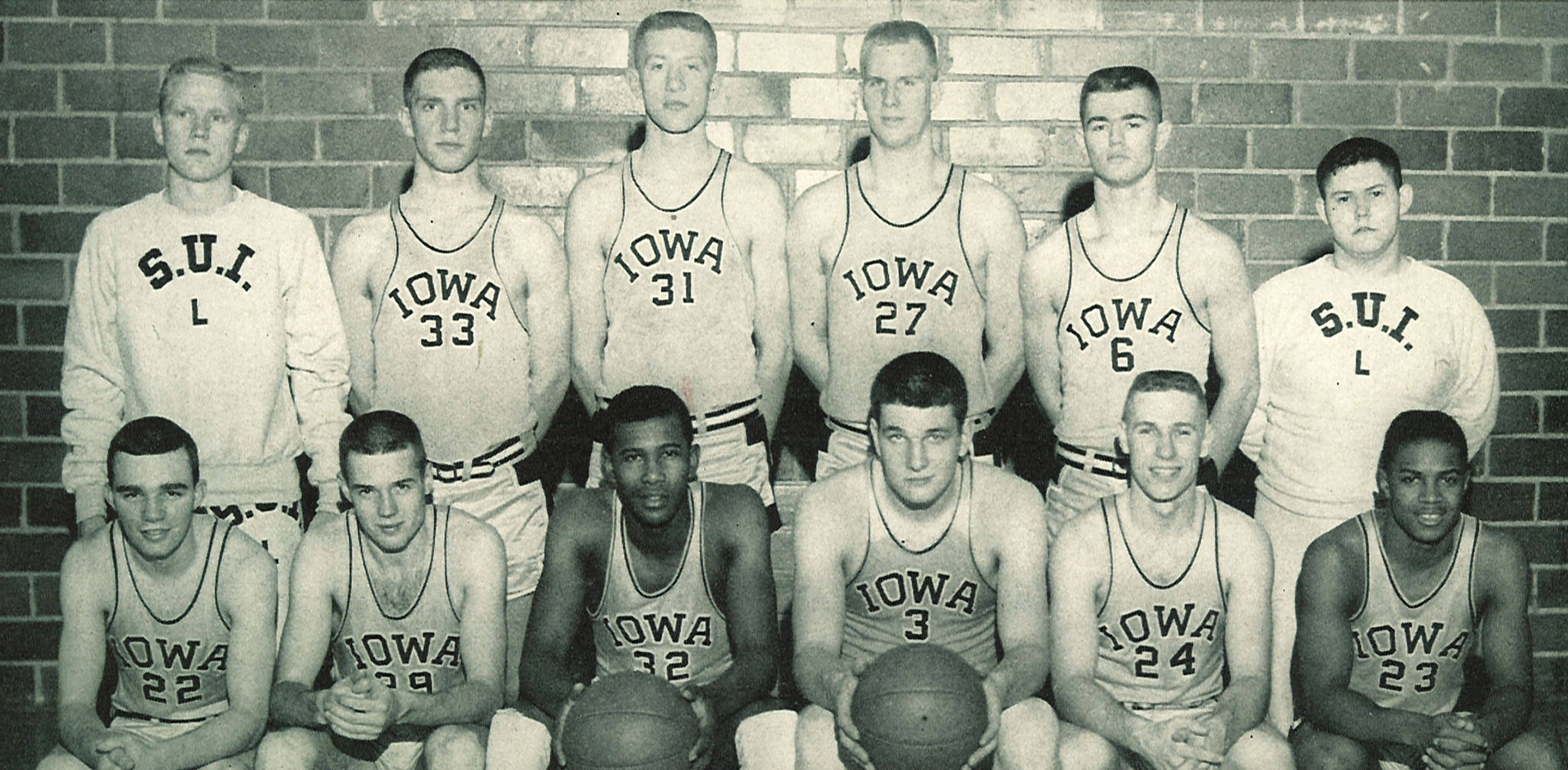
The 1957 Hawkeyes Basketball team. Nolden Gentry is seated in the first row, third from left. Washington is seated in the first row, far right. Hawkeyes 1957 Yearbook
Maybe the adoration went to his head. Perhaps the transition from high school to the university had been too much too soon. As it had been with his future nemesis John Cavanaugh, maybe Iowa City offered too much temptation. Whatever the reason, Washington seemed to lose interest in basketball, especially after Iowa got trounced in a Holiday Festival tournament in New York City’s Madison Square Garden against the University of Cincinnati when guard Oscar Robertson scored 50 points. His Rockford West buddy Nolden Gentry was worried that Washington might flunk out of school; he urged him to put more time into studying or face expulsion. “‘I’ll get to it, I’ll get to it,’ he used to tell me, but he never did.”
University officials on the east side of the Iowa River in the administration quadrangle known as the Pentacrest reluctantly told Coach Scheuerman that he’d have to cut Washington from the team unless he improved his academic performance. By then, Washington had two F’s, both in business-school courses, not because he couldn't do the work, but because he wasn't going to class. By December, Scheuerman was instructed to inform Washington he was out. Washington was 20 semester hours short of the 124 needed to earn his degree.
Back home in Rockford, one of the town’s few black physicians, Dr. Robertson, took a liking to Washington and told him that if he had the desire to go back to college and later medical school, he’d pay for all four years. It was a generous offer, but one that didn’t come close to matching Washington’s talents. Washington thanked the kind doctor but said no.
Six months after ignoring a letter from the Selective Service Board, Washington took a train to Chicago for his Army physical. Because he had blown off the earlier notice, Washington was that same day summarily put on an Army convoy to Fort Leonard Wood in Missouri, and eventually served at Fort Bliss, near El Paso.
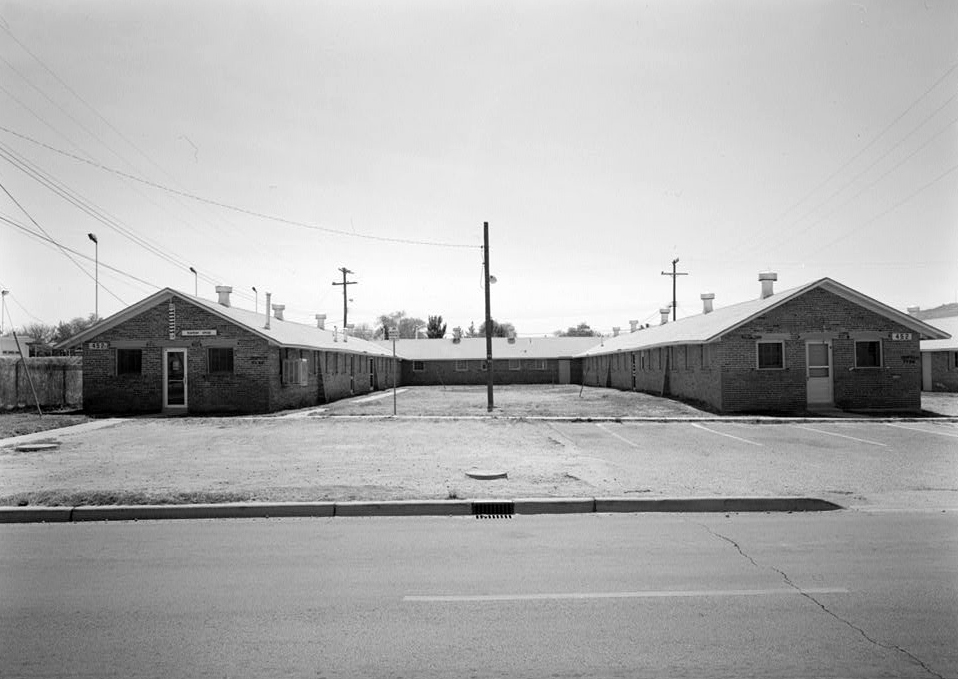
7th Cavalry Barracks at Fort Bliss. Library of Congress Digital Collection
This was 1960. Most white recruits had little understanding of their black counterparts. Blacks and whites lived in two separate and unequal worlds in America; the military was one of the few places where both merged. It made for an uneasy truce.
“Bliss, my ass. Where’d they ever get that name from?” Washington recalled one warm afternoon when we first met several summers ago. “I remember a black guy, he was our platoon leader, and he got into it real bad with a white guy from Indiana one day. The white guy in the worst way didn’t want to be in the platoon. No way was he gonna take orders from a black man. So we formed a human ring, and someone got boxing gloves, and they both went at it. Back and forth they boxed until they couldn’t stand up any longer. They were a bloody mess. The black officer must have pounded some sense into the white guy, or maybe he didn’t, but the white soldier stayed in the platoon. He was either pee-in-his-pants scared or didn’t give a shit and just wanted to do his time and get out. But not another word came out of that white guy’s mouth ever again.”
During the summer of 1961, on R&R back home in Rockford, Washington remembers returning to the Texas Army base, driving south in his father’s blue 1951 Plymouth. Passing through Oklahoma City, Washington saw a sign out front a restaurant, announcing the blue-plate special: Yankee pot roast, mashed potatoes, gravy, string beans.
“Man, that sounded good! I could just picture my dinner on the plate. My mouth was waterin’ just thinking about it. I could taste that pot roast. So, I went into the restaurant all ready to order, and the waitress says to me, ‘I can’t serve you.’ She was an American Indian, I could see that, and she seemed embarrassed, ashamed of what she was saying.”
She whispered to Washington, “But I can get you the meal to go,” and set a plate out the restaurant’s backdoor.
Instead, Washington stomped over to the Dairy Dream across the street, ordered a shriveled-up wiener that came out cold, and sat simmering, as he stared dagger-eyed at the restaurant.
Mapping the Story Click on a place marker to learn about its significance
You learned to behave growing up black in America when Washington—born in 1937—did. You learned limits, how much to push, which battles were worth fighting. You didn’t make eye contact with a white man, particularly a stranger, a boss, a police officer. Lowering your eyes came naturally. If you embarked on a cross-country trip, you were careful. You mapped out a route to find your way to the home of a black friend or relative, or the home of a friend of a black friend or relative. You didn’t chance staying at a roadside motel. That would be asking for trouble. If you tried, even though the neon sign out front flashed vacancy, the last room had always just been rented.
Years later, in the summer of 1973, Bobby Washington, his mother Annie, and his then-fiancée Tamarra, drove to visit Sasser, where Washington had been born. Pretty, warm-but-not-too-hot day, blue skies, lush green all around them, windows down, Washington tuned on the car radio as they were bouncing along the dusty red-clay back roads of southeastern Georgia. Washington was enjoying the trip and where it was taking them.
“Bobby, turn that radio down!” Annie scolded her son. “White people don’t like us playing the radio that loud. What’s wrong with you?”
Washington smiled and turned the radio up.
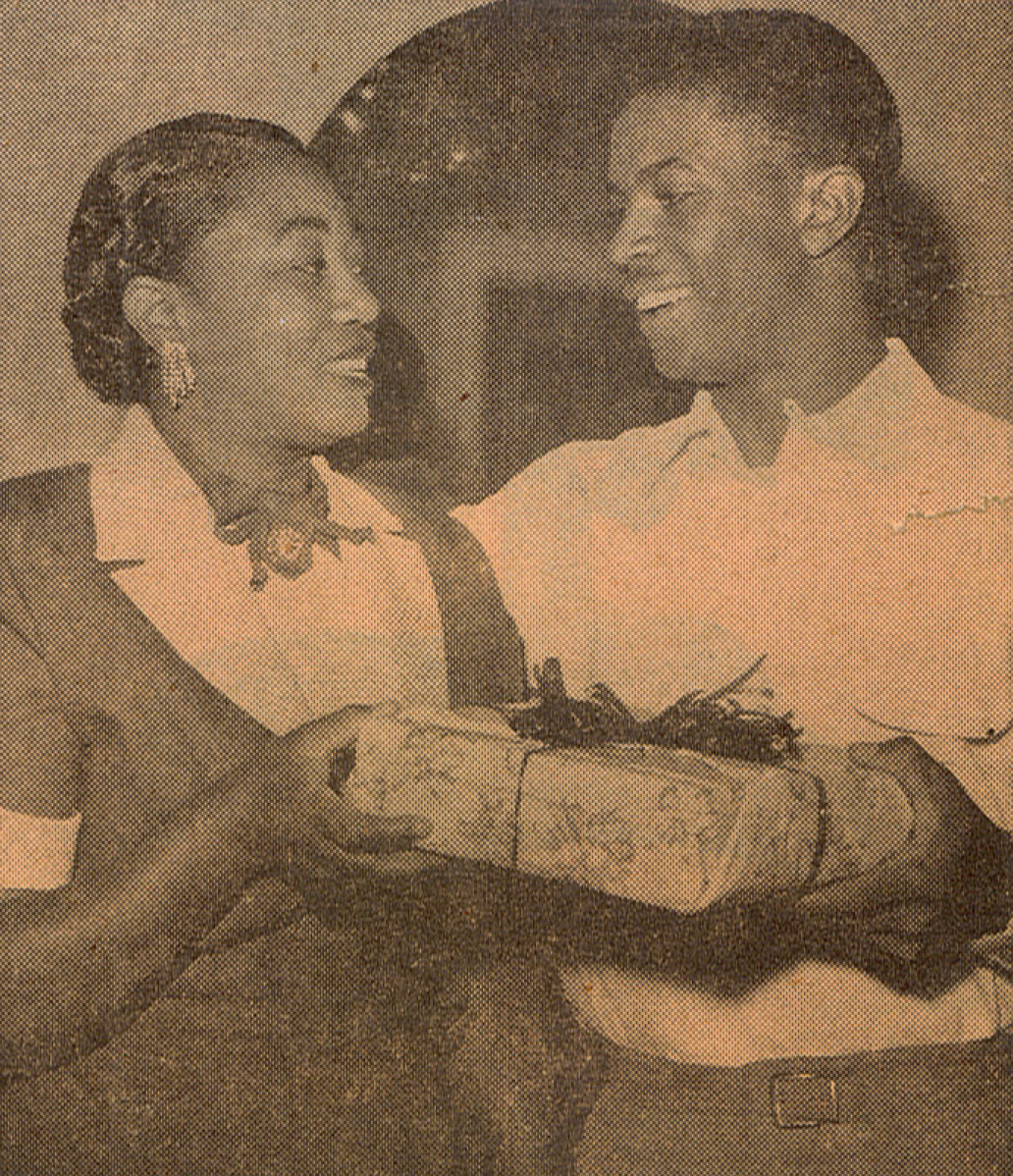
A newspaper clipping from 1956 shows Washington suprising his mother, Annie Washington, with a Mother's Day present.
Chalk it up to the difference between two generations growing up black in America. Annie Washington certainly had the experience to gauge what blacks could and could not do in rural America. Born in 1919 in rural Terrell County, Georgia, she had good reason to be cautious. Her mother, Minnie Lee Howard, remembered one particularly haunting night. What she saw seared her very being. The woman Washington grew up with, reading books to each other at the kitchen table, whom he called Gramp, made sure all her children and all their children and all their children would always remember what happened that night.
“When I was a little girl, I had a cousin who didn’t bow to white people,” Gramp would tell Bobby and all his cousins gathered around her after dinner. “He didn’t take his hat off when he passed them on the street. He didn’t lower his gaze. He was a proud man. Whites in town had an expression for him: They called him a ‘smart nigger.’ That’s what they used to call him, the ‘smart nigger.’ But, Lordy, did he pay for his pride! One night, a bunch of white men in robes extracted him from our house, beat him senseless, and then strung him up and hung him. That’s what you call a lynchin.’”
Gramp remembered hiding under her parents’ bed with her brothers and sisters, shaking like a leaf. She was no more than eight years old. And for several seconds, when she peered up from the floorboards to those big, tall men, she was able to catch a peek under their white-sheet hoods, and she recognized their faces. They were men who lived in town, in Sasser, and by God, she recognized every one of them. She had seen them, each of them, in the grocery store, the post office, the filling station, the pharmacy. She had seen them with their wives and children, some of whom were Minnie’s own age.
The vision of those men’s faces under those awful white hoods didn’t last more than three seconds, but it really lasted a lifetime. Actually, it lasted longer, since the harrowing images and the story that went with them were to be cauterized into the heads of every member of Mrs. Howard’s family for generations to come. The rite of passing on the eye-witness account was a profound and historical act, not unlike Jews retelling narratives of the horrors of the Holocaust from generation to generation to generation to "never forget." The transmission of these stories from elder to child ensured that no one could ever claim that such acts had never happened.

Times had changed, but a dozen years after hearing his grandmother’s story, Washington traveled with the Iowa basketball team, in December 1958, to play Southern Methodist University. He and five other black Iowa players weren’t allowed to stay with the rest of the team in a downtown Dallas hotel. SMU opened its dormitory to put up the six players for the night. At least the black players had been allowed to play in Dallas. Not every city was that magnanimous at the time.
The historic continuum—from lynchings to refusing service to blacks—Annie Washington might have trumpeted it as progress. Down the road from Iowa City, in Moline, Illinois, comedian Jack Benny and his black sidekick Eddie Anderson, who played droll Rochester, performed to a rousing crowd of 5,700 fans at the Wharton Field House in the spring of 1950. At the end of the sold-out performance, Benny was driven to a hotel downtown, but Anderson had to walk to Brown’s Funeral Home, the only place in town that would allow a visiting black man a bed at the time. During the mid-1950s, when jazz titans Louis Armstrong, Nat King Cole and Sarah Vaughn played the Quad Cities, they stayed at the Davenport home of Margaret Williams, a black woman.
Iowa City
Iowa
Honorably discharged from the Army, Bobby Washington moved back to Rockford, where he lived with his parents and found work at a factory that manufactured aircraft components. When he packed up for Iowa City in the summer of 1964, it wasn’t much of a prodigal return. Washington, now 27, was what makes college towns nervous. Past their prime, beset with injuries, once-star athletes now hobbling around town with pinched nerves, bruised egos, and worst of all, attitudes. There was little for these ex-jocks to do but hang out at bars, accept a good-natured slap on the back, and reminisce about the good ol’ days. There weren’t many jobs for a black former athlete-cum-philosopher, now ex-G.I., without a college degree.
Washington made some motions to enroll at the university on the G.I. Bill. However smart he was, his transcript read like many college athletes’. Division I college athletes rarely get prepared for much but athletics. Then and now. Education is wholly incidental in the world of college sports, despite the self-serving platitudes of university officials, obscenely paid coaches, not to mention today’s nonstop loop of feel-good TV commercials about NCAA athletes. Most former college athletes are uncomfortable reminders of over-in-a-blink careers, not to mention how college sports operate: churn out more and more to feed a voracious, money-hungry machine. College athletics, at its core, has always been about four indisputable facts: winning; packing stadiums and arenas; bringing national stature to teams and universities; and most of all, raking in money. Lots of it. Athletes are the geese that lay the golden eggs at most American universities. (The recent move to unionize Northwestern University’s football team, essentially claiming that college athletes are employees not students, underscores the realistic and longstanding status of the college athlete in America.)
Unemployed, descending into a downward spiral, with a penchant for beer ’round the clock, Washington soon discovered that he no longer was one of the Iowa Five. He wasn’t part of much. He no longer had the stuff to whip every head in his direction. He’d become a local has-been. In a college town where 23 is considered old, Washington was ancient. Bartenders no longer poured him free drinks. Boosters no longer paid his rent. This time around, he split a small walk-up apartment above a pizza parlor and bar, Li’l Bill’s, which labeled itself Ye Olde Public House, a jokey nod to being a British pub in the middle of Iowa. Washington’s roommate Willie Bowers, whose nickname was Pops, was a 34-year-old VA hospital attendant whose nightly ritual was to fill a water glass to the brim with cheap vodka and drain it first thing when he woke up. Bobby Washington’s ride was over.
The best job he could find was working the swing shift on the assembly line at the local Procter & Gamble plant, stacking wooden pallets of Gleem Toothpaste tubes. The work was stupefying. Washington couldn’t help but see his own miserable, ignominious fall was complete, a once-soaring arc now flatlined.
More out of desperation than anything else, he thought he might be able to pick up work as a carpenter. At least, he’d be outdoors. At least, he’d earn union wages. To do so, he’d have to register at the Union Hall on South Clinton Street. There were openings, he’d heard.
On the morning of August 8, Washington and Harold Poggenpohl, a local construction worker, bought a six-pack of beer. They swigged the beer, then walked over to Laborer’s Local Union 43. That’s where Washington and Cavanaugh got into their first scuffle. Washington recalls that Cavanaugh, unprovoked, asked him, “Whaddaya doin’ here, boy?” Washington ignored him, but Cavanaugh asked again, and this time, Washington replied, “I can go anywhere I wanna go.” The two argued, then shoved each other. Cavanaugh, at six foot and 185 pounds, was larger than Washington. Washington’s white T-shirt got ripped in the scrap.
Washington went back to his apartment on South Dubuque Street and took the big black handgun his roommate had recently bought and kept in his nightstand. The pistol wasn’t loaded and Washington found no ammunition.
Washington then walked two blocks to Wilson’s Sporting Goods on East College Street, where he bought a box of shells for $10. He didn’t know anything about handguns (in the Army he had learned to fire M-1 and M-16 carbines, but never held a pistol), so he asked the clerk to load the ammunition into Bowers’ gun. The clerk put at least five shells in the metal clip. Washington stuffed the pistol in his front pants pocket.
Washington returned to the Union Hall, but by then, Cavanaugh had left. A police officer passed Washington on his way in and looked at him in a peculiar way. At least, that’s what Washington thought. “He must have seen the gun in my pocket. How could he miss it?” Washington remembers thinking, but the cop said nothing.
On his way back to his apartment, Washington stopped in at Li’l Bills, the tavern on street level. He found a seat at the bar next to his neighbor Paul Coty and asked owner Dave Clark for a beer.
Several men at the Union Hall had told Cavanaugh that Washington had been looking for him, and as Cavanaugh strode into Li’l Bill’s, he made a beeline for Washington. Cavanaugh spun him around on a barstool.
“Get away from me, man,” Washington said. “Leave me alone.”
Sensing a fight, Clark, whom everyone called Red, grabbed Cavanaugh’s arm and tried to steer him out. Clark had been through this before with Cavanaugh, who’d been barred from several taverns in town.
“Hey, Red, need any help?” Washington asked.
As Red was trying to steer Cavanaugh out the swinging front bar doors, Cavanaugh looked back at the bar and pointed his index finger at Washington, cocking it as though his hand was a gun. “I’ll kill you,” Cavanaugh shot back at Washington, witnesses said.
And then it happened.
Washington reached into his pocket, pulled out the handgun, and shot Cavanaugh four times in the chest and neck. The last shot went clear through Cavanaugh and and embedded in the bar’s wall.
“WASH!” shouted Paul Coty.
Washington swiveled around to the bar, placed the gun down on the countertop, and asked Red for his beer.
“You just shot a man!” the barkeep yelled.
Red grabbed the handgun and handed it over to Coty.
Cavanaugh stumbled onto a table and took several lurching steps out the bar’s swinging doors before collapsing on the sidewalk in a pool of blood. A medical student walking by tried to administer first aid as a crowd of stunned onlookers gathered.
Someone flagged down a panel truck and several men picked up Cavanaugh and placed him inside. The driver, Robert Brueggemann, who happened to work for a local funeral parlor, sped to University Hospital, but by 1 p.m., Cavanaugh was pronounced dead.
When the police arrived at Li’l Bill’s, Washington offered no resistance.
As Marie returned to the cabin, Nancy saw her face and immediately knew something was terribly wrong.
Above: Inside Kennywood Park. Photo by Flickr user daveynin.
John Cavanaugh’s wife, Nancy, and the couple’s four young children hadn’t been in Iowa City when the shooting took place. Nancy’s summer courses at the University’s College of Education had just ended and it would be three weeks before fall classes resumed. To celebrate, she and a friend, Marie Reed, took the Cavanaugh children—Kevin, Karen, Kelly and Kathy—to Pennsylvania, where they rented a cabin in Kennywood, near Pittsburgh.
Nancy and John Cavanaugh had planned to talk on the phone that afternoon, but with four children in the bungalow, it was Marie Reed who walked to a payphone in the main lodge to check in with him. Nancy was busy making snacks for the kids. When Marie got through, she was perplexed that her husband, Dick, picked up the party line at the Cavanaugh house back in Iowa City.
As Marie returned to the cabin, Nancy saw her face and immediately knew something was terribly wrong. Nancy slipped out the door and the two women went back to the lodge to call Dick Reed again. Both women were crying when they came back. Nancy took a deep breath, girded herself as best she could, and told the children.
The next morning, Nancy and Marie dropped the children at Nancy’s sister’s house in Mount Lebanon. Nancy’s brother, Bob Sebring, joined Nancy and Marie as they drove back to Iowa City. When they arrived that evening, Nancy said she couldn’t bear to set foot in the house on South Prentice Street. Sebring got everything Nancy needed and they stayed with friends. Nancy and the four children were never to return to the house again. They rented a house on Johnson Street, then on College Street on the eastside of Iowa City.
At the police station that afternoon, officers took Washington’s belt and shoelaces, as well as a straight blade stuffed in his back pocket. Shortly after 5 p.m. at a hasty arraignment, Police Judge Robert W. Jansen asked Washington if he wanted an attorney to represent him.
Washington was too shell-shocked to say anything.
“Do you know an attorney?” Jansen persisted.
“Do you want me to appoint an attorney, Mr. Washington?”
Washington croaked a barely audible yes, and accepted the appointment of local lawyer A.C. Cahill.
“When I heard about the murder, it took my breath away. I couldn’t register what had happened. Washington was a gifted athlete, an easy person to be around. He wasn’t excitable. He never showed any temper whatsoever.”
The enormity of Washington’s actions hit him that night. Handcuffed, he was taken from the courtroom to a jail cell where, exhausted, he slept for three hours. When he awoke, his cell was bathed in an eerie bluish light that came from a street lamp, filtered through bars covering a thick window. Accompanying the light was the clicking of cicadas. The blue light, the hemipterous arpeggio, and by 10 p.m., the rising of a full moon that bathed a shaft of luminescence into Washington’s cell, all of it made for an unthinkable realization. “I remember thinking then and there that I was going to the penitentiary for the rest of my life.”
Anyone who knew Washington couldn’t believe what he had done. Jerry Kinnamon, today an Iowa City attorney, recalls playing on a local softball team with Washington that summer. “When I heard about the murder, it took my breath away. I couldn’t register what had happened. Washington was a gifted athlete, an easy person to be around. He wasn’t excitable. He never showed any temper whatsoever.”
Washington’s former coach at Iowa, Sharm Scheuerman, three weeks before his death in 2010, told me he remembered Washington as “smooth and likeable. He was a good kid. That shooting came from out of the blue, impossible from someone like Bobby.”
Orville Townsend, a football player from East St. Louis, who played for Iowa from 1962–66, and was known as Speedy for his quick-start velocity on the field, said, “Bobby was a quiet, laid-back, positive guy, very mature for his age. If you ever needed something, Bobby was always there for you. When you’re minding your business, and someone tries messing with you, violating you, sometimes that’s a bit too much to take. When you have someone like Cavanaugh, a bully out of control who was hateful and prejudiced, would you be able to allow him to abuse you? You never know until it happens.”
Townsend remembers visiting Washington in jail while awaiting sentencing. “I asked him, ‘What happened?’ And Bobby looked at me and said, ‘Damn Speedy, I can’t let people disrespect me.’”
John Cavanaugh’s autopsy was conducted the day of the shooting, Saturday at 3 p.m., by Dr. Michael E. Korns. Autopsies can reveal many unknown complications of the dead, and the Cavanaugh autopsy was no exception:
- Cavanaugh was shot in the neck, left arm, and trunk, specifically in the back, perhaps as he was falling.
- He had an enlarged heart, a peptic ulcer, and remnants of a lung infection.
- He had various bruises, abrasions and scrapes on his body. These possibly could have come from the fight he had that morning with Washington, but there was such an assortment of bruises on his body that they likely indicated previous fights. He had contusions and serrated bruises that seemed to indicate he had once been in a knife fight. Some of these marks possibly indicated he had taken several nasty falls, perhaps due to intoxication.
- Four bullets struck his body, and three were recovered; one bullet apparently entered and exited his body. (A bullet ended up in the wall at Li’l Bills, and at some point someone drew a circle around it with an arrow pointing to the hole, which became a local curiosity.)
- Although Cavanaugh’s Iowa driver’s license indicated he weighed 210 pounds, Cavanaugh’s actual weight at the time of the shooting was between 180 and 185 pounds, and he was just shy of six feet tall.
His weight was significant. Based on a toxicology screen, Cavanaugh’s blood-alcohol level at the time of death was .304, almost four times today’s level of legal impairment. At his weight, this translated to 14-17 alcoholic drinks in his system shortly before 1 p.m. that Saturday.
John Cavanaugh’s Autopsy ReportAt Washington’s formal arraignment, Cavanaugh’s father, Mark, made the 200-mile trip down from Lohrville. Nancy Cavanaugh and brother Bob Sebring were also there. No one from Cavanaugh’s side said anything at the arraignment, at least publically.
Two weeks later, the Cavanaugh children came back to Iowa City for the school year. Kevin Cavanaugh was going into the third grade at Henry Sabin Elementary School. “Everyone knew me as the kid whose father had been killed,” he recalled. “I remember bursting out yelling in the middle of class not just a couple of times. My mom had to talk to my teacher almost every day. It got pretty bad.”
As an eight year old, Kevin fantasized about sneaking out of his house at night, tiptoeing to the county jail where Washington was being held, shimmying up the drainpipe, slipping into his cell, and stabbing Washington in the heart.
At the time of the murder, Washington’s friend Nolden Gentry had graduated from the University of Iowa Law School and had just begun a career as an FBI special agent in Newark, New Jersey. Gentry flew to Rockford and convinced Washington’s parents to abandon plans to hire a big-city attorney and to stick with the court-appointed counsel. A.C. Cahill, a well-connected lawyer in his 60s with a reputation as a quiet, effective negotiator, had not gone to law school, but had apprenticed himself to a local barrister and had passed the Iowa bar. He was a law partner with Frank Messer, who’d been practicing in Iowa City for more than a half century, had been city attorney and a state representative. A year earlier, Cahill had represented an Iowa man charged with murdering an Iowa City tavern owner, and Cahill had been successful in getting the charges dropped.
Washington was held without bond and charged with first-degree murder. Johnson County Attorney Ralph L. Neuzil returned from Army Reserve training, met with defense counsel Cahill, and agreed to withdraw the first-degree murder charge in exchange for Washington’s pleading guilty to second-degree.
The plea bargain was generous, if not curious. If ever there had been a case for premeditation, this had to be it. Washington had taken his roommate’s gun from a drawer, carried it to a sporting goods store to buy ammunition, had the clerk load the pistol, then went looking for Cavanaugh. Washington fired at least four shots at Cavanaugh. There were eight witnesses to the killing.
At the time, the penalty for first-degree murder in Iowa was death. Executions were by hanging, and all hangings took place at the Iowa State Penitentiary. (Iowa ceased capital punishment in 1965. Read about the last hanging at ISP.)
Cahill grabbed the plea deal.
“We were just relieved that Bobby wouldn’t be hanging from the gallows,” Gentry said.
Prison DocumentationWashington stayed in jail for almost three months. On October 30, 1964, Presiding Eighth District Judge James P. Gaffney, a man with a baritone voice, pronounced just before 3 p.m. Washington’s sentence: a term “not exceeding 60 years at hard labor” at the Iowa State Penitentiary at Fort Madison. The judge asked Washington, wearing a blue suit and tie, if he was sorry for what he did, and Washington promptly replied, “Yes, I am.”
Gaffney did not ask Washington the motive for the killing. There was no mention that it was a black-on-white homicide or that it was prompted in some part by a racial confrontation.
Instead, Gaffney asked Washington: “Do you have any religious affiliation?”
“Yes, I do,” Washington replied. “The Pilgrim Baptist Church.”
“Was your attendance regular or irregular?”
No one was quite sure where Gaffney was going with this, whether Washington’s religion might somehow help him serve out his sentence at Fort Madison or whether the judge was probing to see how a religious man could have been involved with murdering another human being. Whatever the reasoning, Washington answered “irregular” to Gaffney’s inquiry.
“Sentencing a man is not a pleasant duty for any judge,” Gaffney then proclaimed. “But I have a duty to society and a duty to you, and I’m going to try to perform that duty without favoritism. I am satisfied that the ends of justice will be met and that the responsibility to the entire community will be met by accepting this plea.” Gaffney then hammered his gavel, which produced a deep and resolute echo in the ornate courtroom.
By negotiating the lesser plea, with good behavior and Iowa’s indeterminate sentencing at the time, Cahill told his client that he could be released in as little as 14 years.
Washington’s cheeks were streaked with tears. Drellie Washington had to hold up his wife Annie so she wouldn’t collapse.
Washington would later recall that as he was being led out of the courthouse that day, handcuffed, shackled, with an oversized restraining belt around his waist, he saw Judge Gaffney and defense attorney Cahill chatting in an animated way in the parking lot off South Clinton Street. They were both walking with fishing poles and tackle boxes. The two men were about to embark on a fishing trip. Or so it seemed.
Fort Madison
Iowa State Penitentiary
Above: An aerial view of Fort Madison Penitentiary. Photograph from the Iowa Department of Cultural Affairs archives.
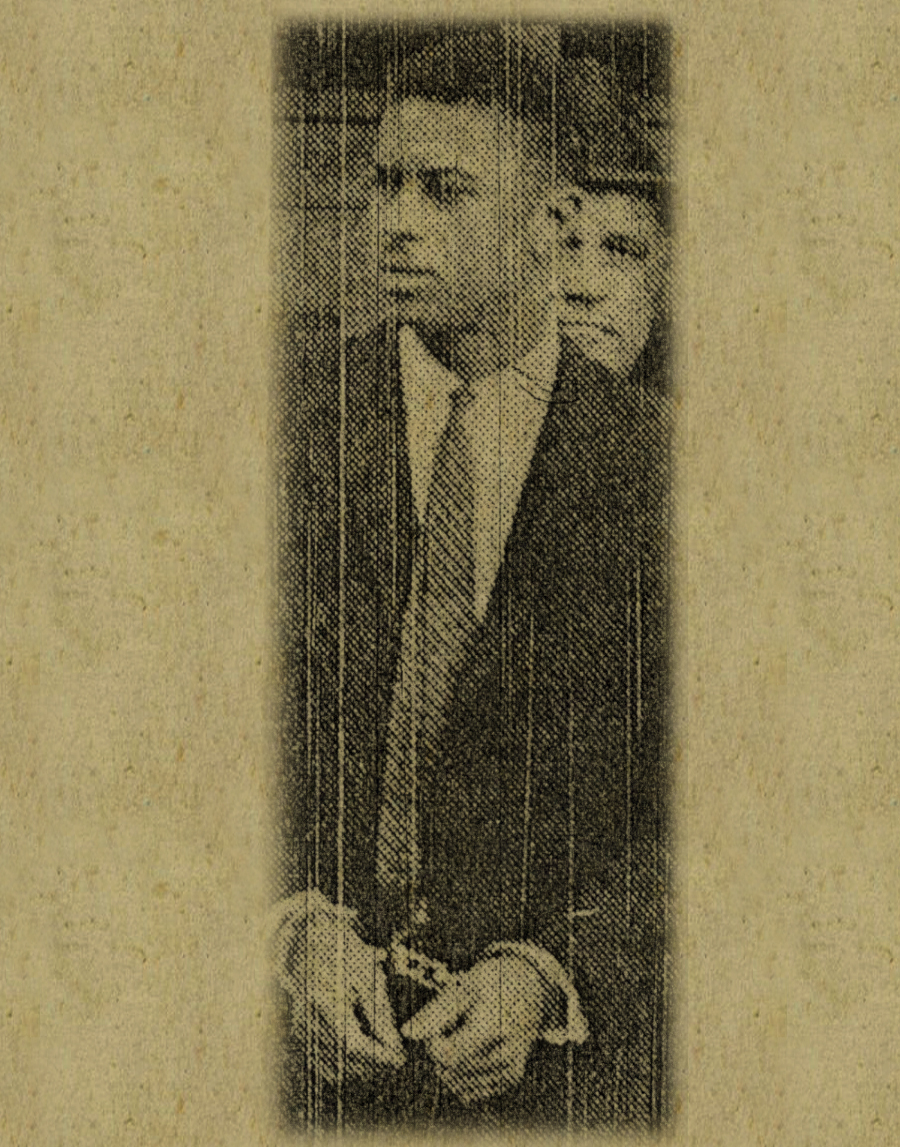
Image clipping from the Oct. 31, 1964 Daily Iowan
That same afternoon, the day before Halloween, David Cook, a Johnson County Sheriff’s deputy, transported Washington the 90 miles southeast to Fort Madison. Cook talked nonstop—about basketball, how the Hawks would do this year, what new Coach Ralph Miller had up his sleeve.
This was one of the few times that Washington didn’t want to talk basketball. He was going off to prison; the last thing on his mind was whether Iowa would beat Michigan this year. Glancing back at Washington through the cruiser’s real-view mirror, Cook talked as though he and Washington were on their way to go turkey hunting for Thanksgiving dinner. For Cook, the two-hour trip was routine; for anxious Washington, it was the longest journey of his life.
Finally, just south of Burlington, Cook got around to the specifics of exactly where they were headed. Cook offered Washington some advice: “Do what you’re told. Stay out of trouble.” Cook couldn’t say when, but even murderers (the word sounded so harsh to Washington, but for the rest of his life that’s what he’d be) got paroled. The key, Cook said, was to behave, to follow the rules, and most of all: Don’t stand out. Cook gave Washington a lit cigarette, and even though it was against prisoner-transport rules, not to mention how difficult it was to smoke with cuffed hands, Washington reached for the cigarette and took a long drag.
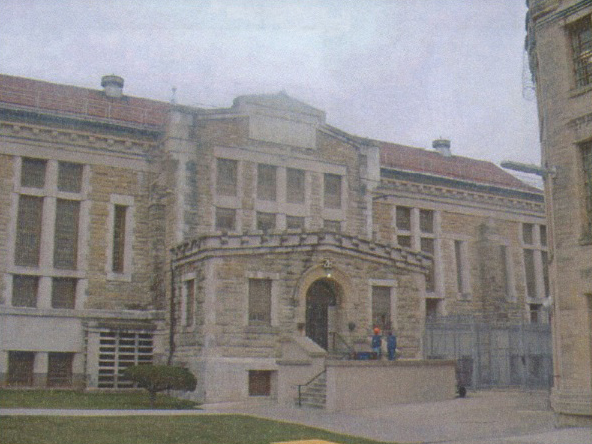
Cellhouse 218/318. Built between 1910 and 1920, it houses general population inmates. Image Courtesy of Iowa Department of Corrections.
Fort Madison was the worst of all Iowa prisons, and fittingly, housed the state’s most incorrigible inmates. One of the oldest prisons in the United States, the Fort, as it is still called, was built a year after Iowa became a territory, seven years before Iowa became a state. The prison hugged the shores of the most American of rivers, the Mississippi, two dozen miles from where Mark Twain once lived and worked. Inmates constructed the prison by quarrying stone from the Sonora Quarries in Hancock County in Illinois and hauling huge cut blocks across the frozen Mississippi. Its ersatz elegance was long gone when Washington arrived. In 1964, the Fort had earned the distinction of being among the grimmest prisons in the United States.
Upon turning the corner of Main and Iowa avenues, driving to the sally port, a secure, controlled entryway to the 55-acre compound, Washington got his first glimpse of the castle-like fortress, a series of connected masonry and concrete buildings with 40-foot-high, razor-topped walls. Washington bid garrulous Deputy Sheriff Cook goodbye.
Washington was stripped, his hair dusted and sprayed for lice. Guards searched his body cavities for contraband. As he walked the flag (the cellblock’s ground floor) for the first time, it was the confluence of odors that struck him. The cellhouse was stifling. Too many men jammed into too little space. The temperature must have been more than 90 degrees. And it was autumn. The air was stagnant as though it, too, was incarcerated. The prison reeked of body odor, urine, feces, vomit, sweat-soaked prison uniforms, along with the equally repellent stench of harsh disinfectant. Washington instinctively rubbed his nose.
In the dining hall that evening, his first meal was goulash, a lumpy brown paste that resembled diarrhea.
Like at all prisons, few inmates at Fort Madison copped to the crimes they were convicted of. They were framed, had under-prepared and overworked court-appointed counsel, were notches of political achievement for zealous judges or prosecutors, their co-defendants had flipped to make a self-serving deal. But Washington was different. He volunteered that he had shot a man to death. There was no percentage in denying it. The philosopher Descartes’ in play: Washington made no disconnect between body and mind. He was solely responsible for his actions.
Because he was in for murder, Washington would be granted a degree of respect among inmates. That was prison code and hierarchy—as long as the murder didn’t involve a juvenile. Inmates would give him a wide berth. The murder might have been uncharacteristic of Washington, but inmates didn’t know that. They knew what he was capable of.
Washington was shown his new home, a six-by-eight-foot cell on the fourth and top floor of Cellhouse 217, the last of the original buildings of the original penitentiary. In prison argot, Washington was a fish, a new inmate, and his cell was along fish row, where all new prisoners were housed. Next to him was 17-year-old John Kyle, a bank president’s son who had stabbed to death the 19-year-old sister of Dan Gable, who’d go on to win a Gold medal at the 1972 Olympics and become head coach of Iowa’s nationally ranked wrestling team.
Washington’s daily routine would be identical to Fort Madison prisoners of a century earlier. Inmates were awakened by a 6:30 a.m. whistle, filed for breakfast and work at 7:30 a.m., and returned for a head count at 11 a.m. They moved at the command of the prison whistle, which blew at noon for dinner (in rural Iowa, the mid-day meal is dinner, not lunch). At 4 p.m., there’d be another head count. After supper, depending on the season, from 5 to 6:30 p.m. prisoners congregated in the Yard, after which they’d return to their cells for another head count and lockup. Inmates received two hand towels per week and a change of sheets once a month. They were allowed two showers a week.
Washington’s first job was clerk to the Deputy Warden for Treatment, working alongside an inmate everyone knew as Suzy. His next job was as a photographer, shooting mug shots for the prison’s inmate magazine, The Presidio. For his third assignment, he worked as a records clerk for the prison psychiatrist. That’s where he scored big.
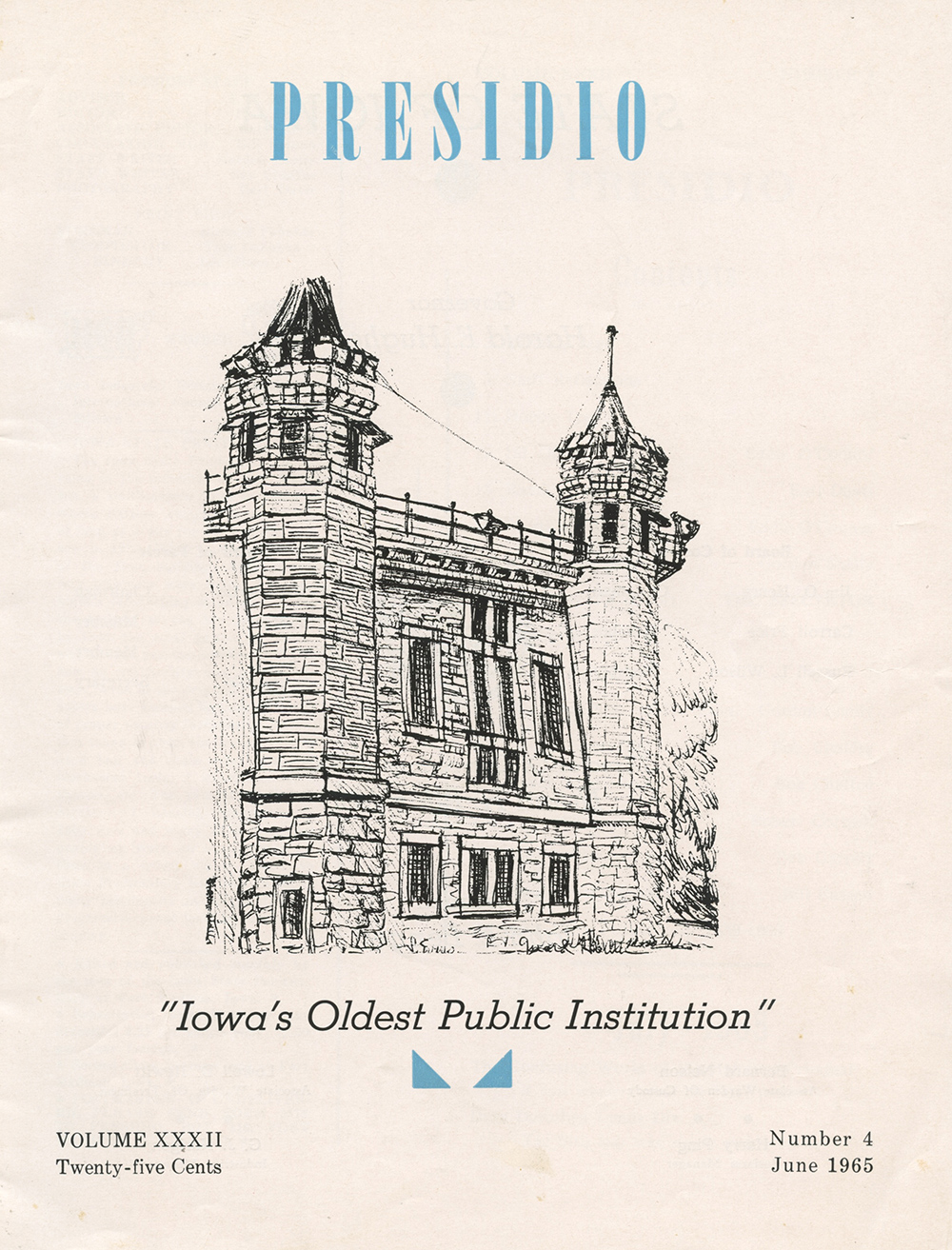
Psychotropic drugs were an essential antidote to the violence and chaos of prison life, and Washington’s job was to distribute those drugs (the antipsychotic chlorpromazine, known as Thorazine, was the most prevalent at the time). Prison recordkeeping was so lax that Washington soon discovered that he was able to write scripts as well as fill them without the prison psychiatrist’s signature. As he had been while playing for Rockford West and Iowa, Washington became the inmate’s go-to guy. Soon he had earned a nickname: Dr. Bobby.
His next prison job was in the laundry, then for three years he worked as an attendant to Warden Lou V. Brewer, washing the warden’s cars, mowing grass, raking leaves and shoveling snow. Back in his cell at night, Washington read Sports Illustrated (a gift from his parents) and James Bond novels. He wrote a short story for The Presidio, titled Hell Week. During exercise in the Yard, he naturally excelled at sports. Twice he scored 39 points, and once 51 points in basketball games against teams from outside the Fort.
More than 1,000 inmates were housed at the penitentiary, controlled by staff and correctional officers, known as heads, bulls and screws. Washington got ushered into a self-contained world of turks, pitchers, catchers, daddies, and punks (dominant or passive homosexuals), CERT (Correctional Emergency Response Team) to control inmates deemed overly aggressive, prisoners with rabbit (those who’d try to escape), bugs (inmates who were nut cases), and icemen (hardened prisoners). There were inmates in P.C. (removed from the general population and placed in a Protective Custody cellblock) and others in P.C./P.C. (inmates placed in Protective Custody within a Protective Custody cellblock). Washington was to meet inmates who took the Dutch route (committed suicide), usually with rolled-up bed sheets, a doubled-over mattress, and a toppled chair. Square Johns were inmates who allied themselves with prison personnel. Outside of working for the prison shrink, one of the most envied jobs at the Fort was being a lumper, delivering sheets and towels cell to cell, as well as hot water for shaving and bathing, along with any contraband items lumpers could get their hands on. Inmates paid lumpers with gifts of cigarettes, marijuana, food, cash, or rook, inmate-brewed hooch. Read More About Lumpers.
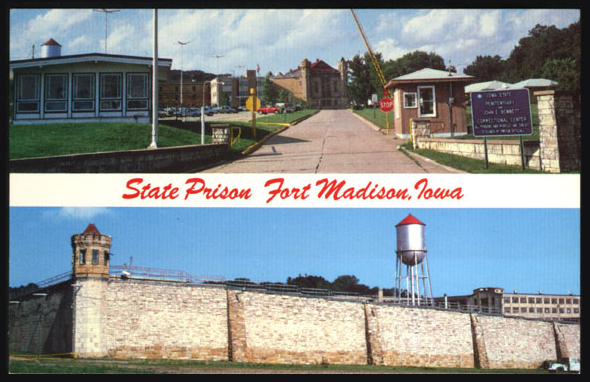
A postcard featuring Fort Madison from the 1960s.
What Washington most missed was being alone. There were always men, their smell, their farting, snoring, coughing, sneezing, masturbating—the constant sense that someone was next to you, on top or below you, watching you, ready to pounce. Then there was the round-the-clock prison hustle, a nonstop triplethink that forced inmates to consider: “Why’s he doing that? What’s his scam? What’s in it for him?”
Washington soon got swallowed up in what penologists call “prisonization.” It starts by becoming an anonymous figure, a number replacing a name, the wearing of identical inmate clothing, the demand for obeisance around the clock, living under maddening rules and routines, the forfeiture of personal possessions. If there's any silver lining to prisonization at all, it's that it can make inmates wildly resourceful. Prison hooch was one example, jigger poles another.
Washington became an expert at building jigger poles, rolled-up papers that could telescope 20 feet or more to pass messages (kites) and contraband between cells. He also learned how to shoot jiggers—maintaining a lookout for approaching guards.
He met inmates who had trained cockroaches to send and retrieve cigarettes from other prisoners’ cells. One inmate in for life for first-degree murder, Michael Gavin, used to train rats by feeding them cheese. Another prisoner, Noah Sheffey, built a zip gun from a purloined allen wrench.
At the center of the Fort was the Yard, each square inch staked out along strict, unwavering racial lines. A group of white inmates, who called themselves the Shit Kickers, took over the Yard between the mess hall and the north end. Every day, they brought out instruments and played booming, deafening music. Their leader was an inmate whose baldhead had a red-and-orange blaze tattooed on it (he went by Flame, but his name was Charles Fetters, also in for second-degree murder). The black convicts tried to muscle the Shit Kickers with their own jazz and blues band, located on the south end of the Yard.
Washington chose his friends carefully, and mostly hung out with another inmate, J.J. Johnson, in for burglary and hijacking an eighteen-wheeler.
Prisoners who stepped on someone else’s turf were asking for trouble, with most beatings and rapes taking place in the cellhouse shower rooms. Violated inmates seldom complained to guards; if they did, they’d be branded as snitches, which begot more violence directed at them.
The old prison credo—“If you see one prisoner alone, he’s crazy; if you see two together, they’re lovers; if you see three, they’re planning an escape”—by and large rang true. If inmates had been convicted of first-degree murder, baring an unlikely pardon or successful appeal, they were going to die in Fort Madison. This had the inevitable effect of lowering the bar for trying to escape. Escapes have always been a part of prison, but more so at a run-down penitentiary with murderers in for mandatory life sentences. Men who knew they were going to die in prison had no reason not to try to escape. What was there to lose? Of course, they could get killed and they could get thrown in solitary confinement if caught, but the specter of freedom generally trumped either of these contingencies.
“You could almost smell rabbit,” Washington said, musing about convicts he knew sooner or later would bolt.
After each prison break, there’d be a lockdown, which became so onerous to the mainline population that it often led to riots and fires on small and large scales. Inmates and guards alike stood in fear of the dreaded institutional signal of a riot’s onslaught: one long, two short, and one long whistle blast. The last words in the red-cover prison booklet, Rules, Regulations and Disciplinary Procedures for the Government of the Iowa State Penitentiary Inmate, issued to every inmate, read:
IN CASE OF RIOT OR INSURRECTION OF ANY TYPE, THERE WILL BE NO BARGAINING BY AUTHORITIES WHILE DISORDER EXISTS. THE RIOT OR INSURRECTION WILL BE STOPPED BY WHATEVER MEANS NECESSARY
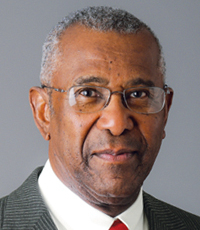
Gentry
“There is nothing inspirational about that institution. It’s decrepit. It’s horrible for both inmates and for anyone who works there. I was happy to get out when I left. Prisoners get no training. No inspiration. You rot there.” — Nolden Gentry, on visiting Washington at ISP.
Brutality was an accepted part of life at the Fort. Inmates dominant in rape were not viewed as homosexuals, but men exercising power and authority, showing off their manhood. The raped inmate was looked at as a homosexual because he was weak and had been forced into submission.
Washington’s old buddy, attorney Nolden Gentry, recalled visiting Washington once, and only once, at the prison. He said, “Fort Madison was a horrible place. It was unbelievable. There is nothing inspirational about that institution. It’s decrepit. It’s horrible for both inmates and for anyone who works there. I was happy to get out when I left. Prisoners get no training. No inspiration. You rot there.”
Washington tried to transcend the institution, said Speedy Townsend. “Bobby was different from a lot of people in that population. He didn’t let prison change him.”
As Washington told Judge Gaffney, he was not a man of religion, and particularly in Fort Madison, observance and allegiance to a religious schema were not for him. He supplanted religion with his own code: belief not in a supreme being, but in himself, belief in his own perservation.
Washington’s parents would make the trip to the prison from Rockford twice a year, and once they brought his daughter, Regina, who was a teenager at the time. But Washington never encouraged the visits: “I didn’t want visitors. I liked it that way. Who wants to go to a prison to see someone, especially someone they love?”
But what kind of job could an ex-con just released for murder ever hope to get?
Above: The cafeteria at Fort Madison. Photograph from the Iowa Department of Cultural Affairs archives.
Washington’s murder of John Cavanaugh was deemed by prison authorities a “situational offense.” Washington had no prior criminal record and he maintained an exemplary record as an inmate. Just as importantly, the warden liked and trusted him. Washington had worked at the warden’s home on the other side of prison’s razor-topped fences, after all.
He was released from the Fort the first time he appeared before the Parole Board in 1971, less than seven years after his conviction. No one from the public opposed his release. It is unclear whether Nancy Cavanaugh, John Cavanaugh’s widow, was alerted to Washington’s parole hearing. There is no record of any communication to or from any member of the Cavanaugh family.
Washington had been transferred to another Iowa correctional facility, the Riverview Release Center, in Newton, in 1968, and finally sent to a minimum-security facility in Mount Pleasant. Through a prison-education program, he received a bachelor’s degree from Iowa Wesleyan College, the degree that eluded him at the University of Iowa. He was paroled in April 1971.
Was it too little time to serve for murder?
Robert Washington's Parole AgreementOutside of a pardon or successful appeal, the Parole Board makes all prisoner-release decisions. Judges prescribed general sentencing parameters, but prisoners (those not in for first-degree murder), in principle, could be released any time. The rationale behind the policy is to encourage rehabilitation and reward it with early release when warranted.
Ralph Neuzil, the Johnson County prosecutor who had agreed to let Washington plead to second-degree murder, knew that Judge Gaffney’s 60-year sentence meant little. “I have no second thoughts, no bad feelings, about this case,” Neuzil told me when I interviewed him in 2010 (Neuzil died a year later). “I’ve got nothing but a good feeling for someone who had a lot of strikes against him and overcomes adversity and succeeds. That seems to be the case here.”
While Washington was still in custody in the halfway house in Mount Pleasant his parole officer, Lee Johnson, asked him whether he’d ever consider working at Fort Madison.
Washington thought Johnson had to be kidding. Washington had been incarcerated for 78 months. And he was about to be set free. No way would he voluntarily go back to Fort Madison.
But what kind of job could an ex-con just released for murder ever hope to get? What kind of job could a black ex-con just released for murder ever hope to get in Iowa?
According to the terms of his parole, Washington would have to stay in Henry County, Iowa, for two years. What was there for him? How would he make any money? How could he not get into trouble?
Washington knew that few prisoners ever get rehabilitated. Fort Madison was a one-way dead-end street. “Prison makes you into a lifelong felon. If you ever get out, you have a hard time staying out. It’s just a matter of time before you come back. Once a con, always a con,” he said.
Given the grim economic choices, he could at least try working at the prison. Two years maximum, then he’d get on with his life. So, he took a job as program coordinator of prisoner activities. His starting annual salary was $8,600.
Inside the prison now as part of the staff, Washington had to be careful, staying within the rules and culture of the penitentiary, and guarding against being compromised by inmates looking to extort him. Don’t ask questions, don’t stand out, stay clear of the hustle even as a prison employee.
Washington found himself living an existential existence, befitting a character out of a Sartre or Camus novel. Guards would never fully trust him. How could they? The same correctional officers who had locked him in his cell every night now had to work side-by-side Washington as equals. Washington was now protecting their backs. And from the inmates’ point of view, they all knew Washington had been one of them, and because of that, Washington couldn't show them any favoritism—even though they expected it. If word ever got round that Dr. Bobby was back, he’d be toast with the guards, who monitored his actions, looking at closed-circuit videos of his interactions with prisoners.
It was a bizarre, watch-every-step dance. Through it all, there were shards of humanity that Washington was able to import into Fort Madison. One of them involved the prison football team.
All images feature the 1974 ISP Bulldogs.
Washington’s first assignment was to be the prison's assistant football coach. For two years, he and head coach Bill Bailey put together a ragtag team of murderers, rapists, kidnappers. Half were white, half were black. Some hated life, hated each other, and resisted all attempts at taking direction from an assistant coach who had become a turncoat. But even if Washington couldn’t cut deals, show leniency or dole out special treatment, he could play to an inmate's cutthroat temperament.
Football is one of the few sports that allows contact and encourages violence, so it was a natural for many inmates. Washington’s first problem was that some of the men hit too hard. Some pounded their fists into anyone whenever they had an opportunity. Prison football could be more of an excuse to beat up on someone than it was a game. Washington could handle that.
The highlight of the first year was when Washington somehow negotiated to have the team board a bus and play another prison team at Anamosa, 75 miles north. Freedom! If only for an afternoon.
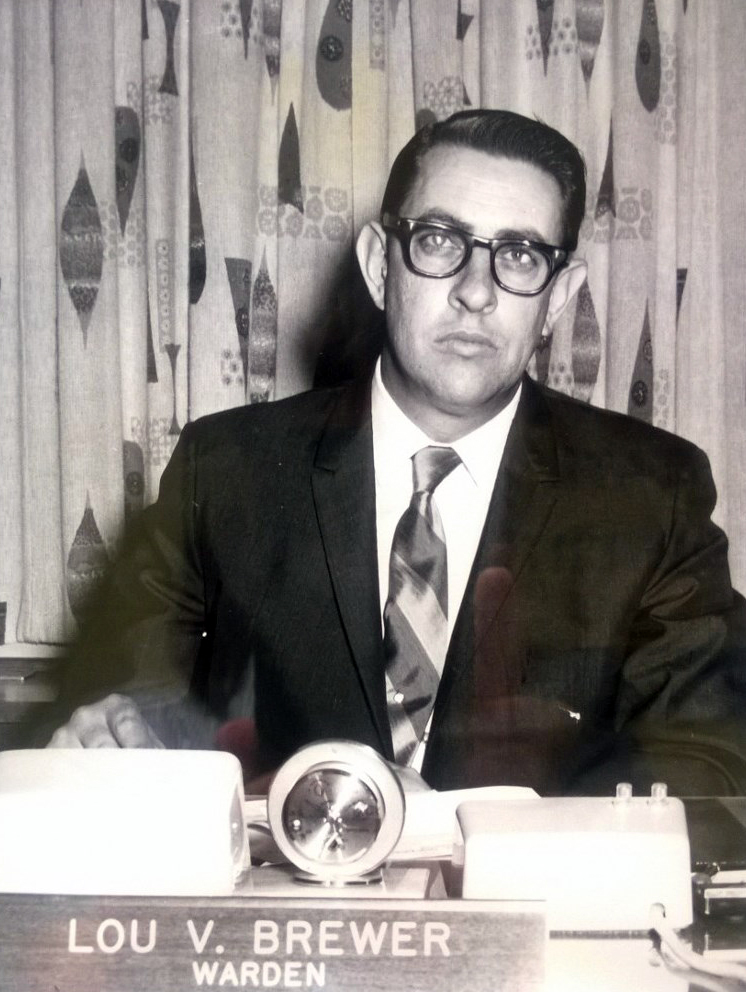
Warden Lou Brewer. Image courtesy of Iowa Department of Corrections
Through drills, daily scrimmages, chalkboard diagrams, the prison team celebrated a glorious season, 6-1, a year no one would forget—including Warden Brewer, the man Washington once worked for doing chores around his house. Football cost the financially strapped prison money and resources. Brewer complained to anyone who would listen that football got the prisoners rowdy, that it was too physical. Worse: It made them independent, harder to control. It gave them attitude. More than they already had.
Brewer killed the team that winter, a story covered in the inmate-run magazine, The Presidio. Whether the football team was the tinder that set Brewer off is unclear. Prison personnel I talked to said Brewer had become unhinged at about the same time for a number of reasons. By then, he had begun what inmates called a reign of terror. In May 1975, the Fort exploded in riot. The prison whistle blew those four dreaded blasts—one long, two short, one long.
Two dozen prison officers were held hostage. Hundreds of cellhouse windows were smashed, plumbing ripped out of walls, guard control rooms destroyed, locking mechanisms broken, holes punched in walls, shower rooms demolished. After the insurrection was quelled, Cellhouse 20 was packed with the inmates who had rioted. When The Presidio came out two months later, the cover was an artist's rendering of the front gates at Auschwitz with the notorious sign, Arbeit Macht Frei (Work Makes You Free).
Washington took cover during the riot. He was perhaps the only prison employee who understood why the inmates were so hell-bent on destroying the Fort. There was little he could do except punch his timecard, watch, shake his head, and go about his job.

A copy of the cover for the Summer/Fall 1975 issue of The Presidio
The problem wasn’t as much the prisoners as it was the prison staff. Trying to find competent correctional officers in a rural, out-of-the-way town like Fort Madison has always plagued the prison. The caliber of guards was abysmally low, and the meager salary did nothing to improve that standard. Correctional officers were constantly compromised. Washington had seen this as an inmate as well as a staffer. It started with small favors — an inmate asking a guard to send out a letter, then it would escalate: asking a guard to bring in a pair of sneakers, cigarettes, a pinch of marijuana—until the inmate had enough on the guard to extort bigger favors.
Outside of the warden and several associates in his immediate circle, few personnel had college degrees. Guards were suspicious of anyone who’d gone beyond high school. Many correctional officers were local farmers who worked at the prison to supplement their incomes. Hiring multi-generations of the same family was so common that not to have a relative employed at the penitentiary was unusual.
At the beginning of Washington’s incarceration, there were no gangs at Fort Madison. “They’d beat your ass to a bloody pulp if you said you were a Crip or a Blood. They’d lock you up forever if they found out you were a gang member.” (Now, 80 percent of prisoners at Fort Madison join a gang, either voluntarily or through coercion. The most popular is the Chicago street gang, the Vice Lords, known as the VL).
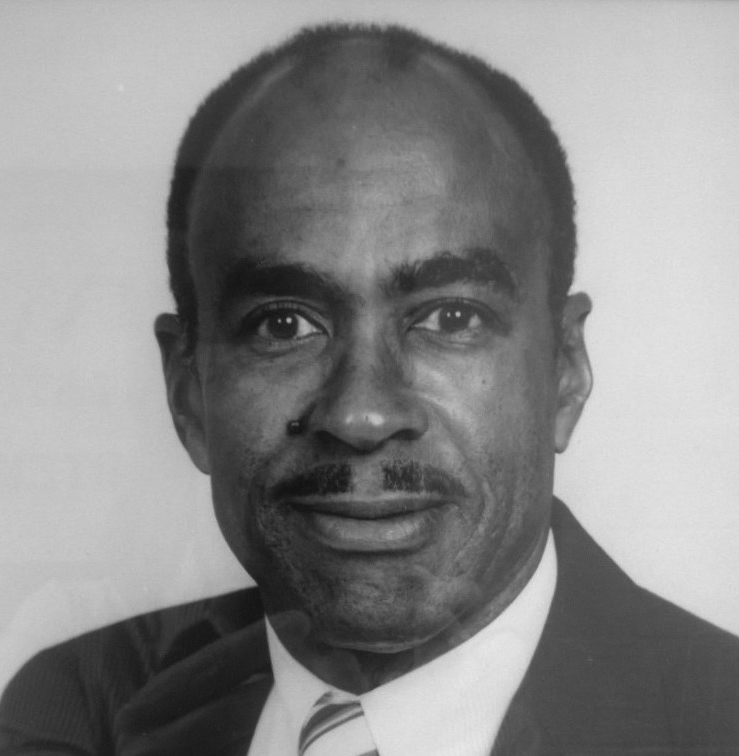
Warden Crispus Nix. Image Courtesy of Iowa Department of Corrections
The most effective warden under whom Washington worked was Crispus Nix, the former director of protective custody at Fort Leavenworth, the medium-security federal prison in Kansas, operated by the Department of Defense. Nix happily copped to his lifelong reputation, “the warden inmates love to hate.” He thoroughly dismissed the concept of prisoner rehabilitation, saying his job was to protect society from violent, savage men, and used any means the courts would allow. “To me, warehousing is no longer an offensive term,” he said while at Fort Madison. Nix sought to protect inmates from each other, as well as from ineffective guards. “A good warehouseman will keep his products safe. If the warehouse is destroyed, he has failed to do his job.” Warden Nix’s doctrine was legendary at the Fort. “Every time you give inmates something, then they want something else. I prefer total control, particularly in a maximum confinement setting.” He had a name to describe ornery inmates: orangutans. Nix, a staunch advocate of the death penalty, was warden from 1981 to 1993. Since then there’s been a revolving door of wardens at Fort Madison, until the most recent warden, Nick Ludwick, was appointed four years ago.
Through it all, Washington solidered on. Fort Madison provided him with a steady job and income, if not much else. Three quick seconds long ago had wholly created the contour of Washington’s life. Ultimately, he rose in rank at the prison to become Unit Manager for his last 16 years. In 1997, after 25 years—almost 31 years counting his time as an inmate there—Washington retired. His salary was $44,000.
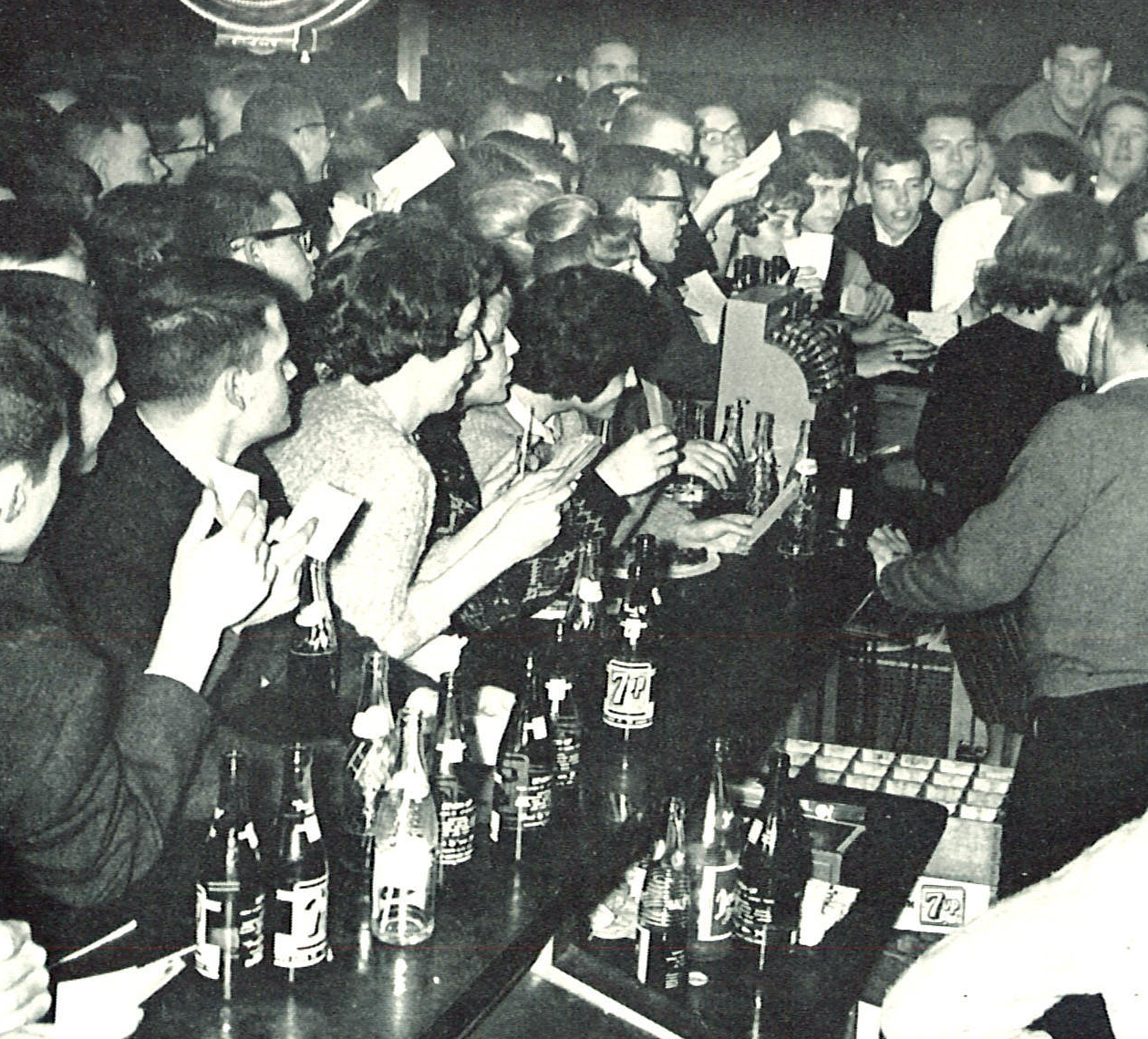
Students drink at a local bar during Greek Week, 1957. University of Iowa Digital Collection
Back when Washington first moved to Iowa City, some 25,000 of the state’s 2.6 million inhabitants were black, comprising less than one percent of the state’s population. When Washington was recruited at the University of Iowa in 1956 to play basketball, to maintain its preeminence in athletics, the university had to recruit fast and furious to attract the nation’s premier athletes, especially black athletes. It wasn’t an easy proposition, no matter how successful the previous year’s season had been. Under Coach Bucky O’Conner, the basketball team had been nationally ranked, so that was a draw. But why would a black athlete choose Iowa, of all places? For one, there wasn’t a whole lot to choose from when it came to nationally ranked teams for a black athlete. At the time, many of the nation's top programs neither recruited nor welcomed blacks—no matter how talented they were. Both the University of Florida and University of Texas didn’t have a black player on their varsity football squads until 1970; the first black athlete to play LSU football wasn’t until 1972. In the world of collegiate basketball, it wasn’t any better. At the time, neither Louisville nor Kentucky, or scores of other teams, had ever had a black player.
Iowa’s athletic recruiters have always had their work cut out for them to attract prime black athletes to Iowa City. Urban blacks like Washington have always found living in Iowa something of an ordeal. There are large and small issues that confront them on a daily basis, and one of the seemingly minor yet persistent thorns has always been haircuts.
When Washington was a student, local white barbers got around giving haircuts to blacks, claiming they didn’t know how. This could be correct: If barbers never cut a black person’s hair, they could manage to say they didn’t know how. That tonsorial practice stopped when a kinky-haired white student by the name of Bill Kutmus in 1963 got a haircut. When the barber removed the white cape from Kutmus with a flourish, Kutmus jumped out of the chair and proclaimed to the barber, and a line of activist friends who had gathered outside, “Now you can cut anyone’s hair!” Thus, Iowa City barbers had no choice but to begin cutting the hair of black men. They’d been had by Kutmus, who today is one of Iowa’s shrewdest criminal defense attorneys.
The barber incident was the tip of subtle and not-so-subtle racism when Washington was an athlete at the university. Washington had carried the straight razor in his back pocket every day since he was 19. Washington had lifted the blade from his father’s basement barbershop in Rockford. He never left home without it. You never knew what to expect. Being an athlete cut both ways. Better to protect yourself than leave yourself open. Washington felt safer with that blade tucked away wherever he went.
Once on a date with a white girl, Washington recalled, three white men spotted them in a downtown parking lot. The men pointed at the girl and Washington, then began closing in on them. Washington instinctively reached for the straight blade, but his date talked him down and they ran to his car and sped away. Washington’s black friends counseled him that he had been foolish to be seen with a white girl. Confine your activities with white girls to inside a car, they advised. Going to dances or the movies with a white girl was not recommended.
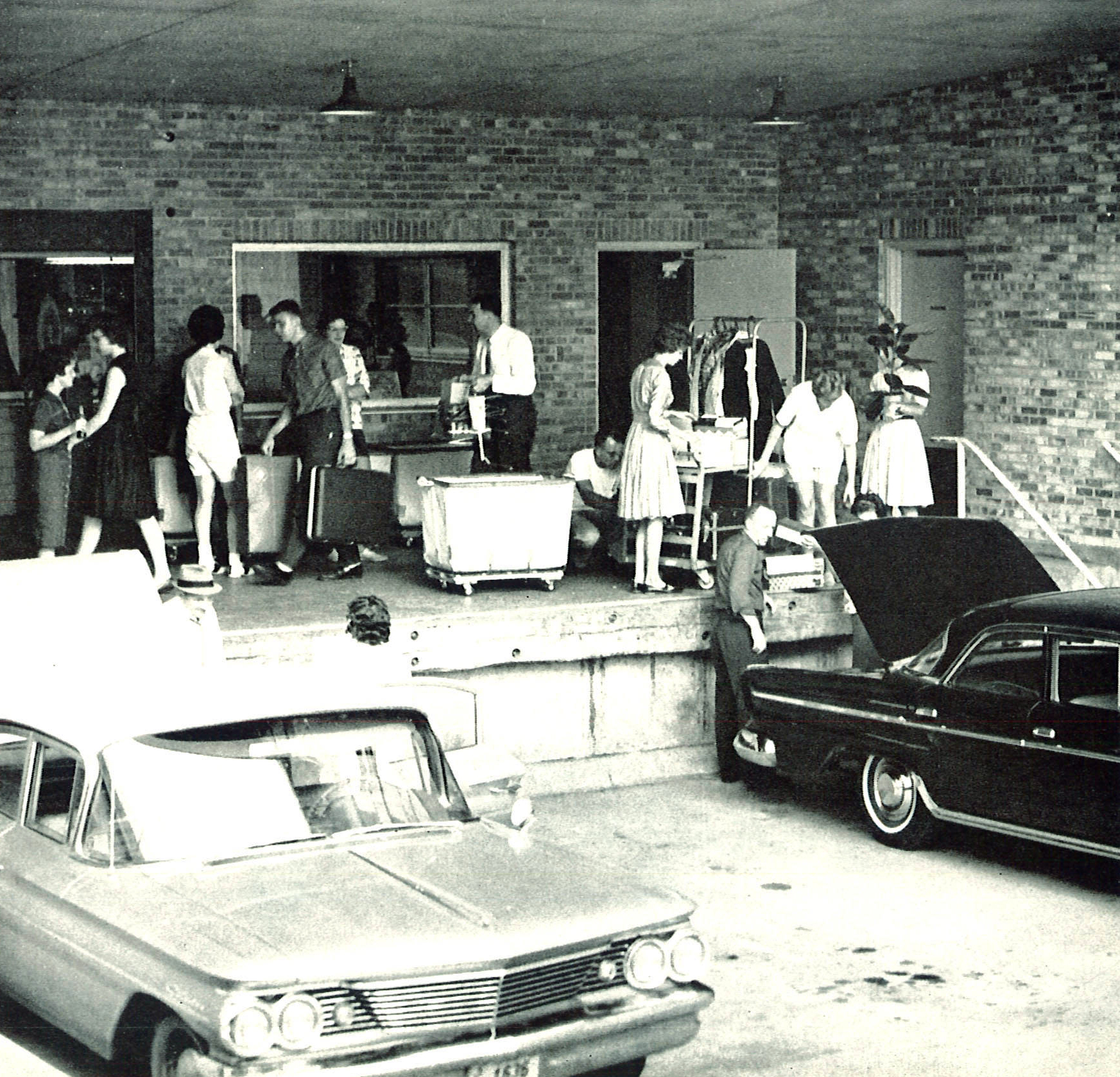
Students are helped by parents as they move into their dormitories at the University of Iowa in 1957. University of Iowa Digital Collection
In his sophomore and junior years at Iowa, Washington was serious enough with a white Iowa City girl for her to ask her parents whether she could bring Washington home to meet them. But the girl’s father said he’d have nothing to do with his daughter’s dating a black man. Still, one afternoon the girl brought Washington to her house, while her father was at work, to meet her mother and brother. When Washington called his parents, telling them he wanted to bring the girlfriend home for a weekend, a similar scenario played out, only reversed along gender lines. Washington’s mother said, “That’ll be fine,” then asked anxiously, “Is she white?” Muffled through the phone, Washington overheard his parents’ arguing, and when Washington spoke to his father, Drellie replied, “I own this house, and if you want to bring her here, that’s fine.” Washington and the girl made the visit to Rockford, met the Washingtons, but the relationship petered out.
Whether it was out of habit, bravado, or necessity, Washington never went anywhere without the straight razor in his back pocket. Similarly, Washington’s black roommate in the apartment above Li’l Bill’s, Willie Bowers, hadn’t bought himself the pistol to hunt deer. It was for self-defense, real or imagined. Speedy Townsend, today a retired social worker and member of the Iowa City School Board, recalls, “Blacks back in the sixties didn’t think the law was there for us. You were in Iowa City, you were at risk. It was nothing for a carload of white guys to stop and use the N-word. Back then, blacks weren’t welcomed in Iowa City. That’s why Bowers had the gun. It was for protection.”
Townsend, also a member of the city’s Human Rights Commission, remembered that one evening in his college years at Iowa, he stopped by a friend’s room in Hillcrest Residence Hall, and a “white guy walked in and says, ‘Hey, what’s this nigger doing here?’”
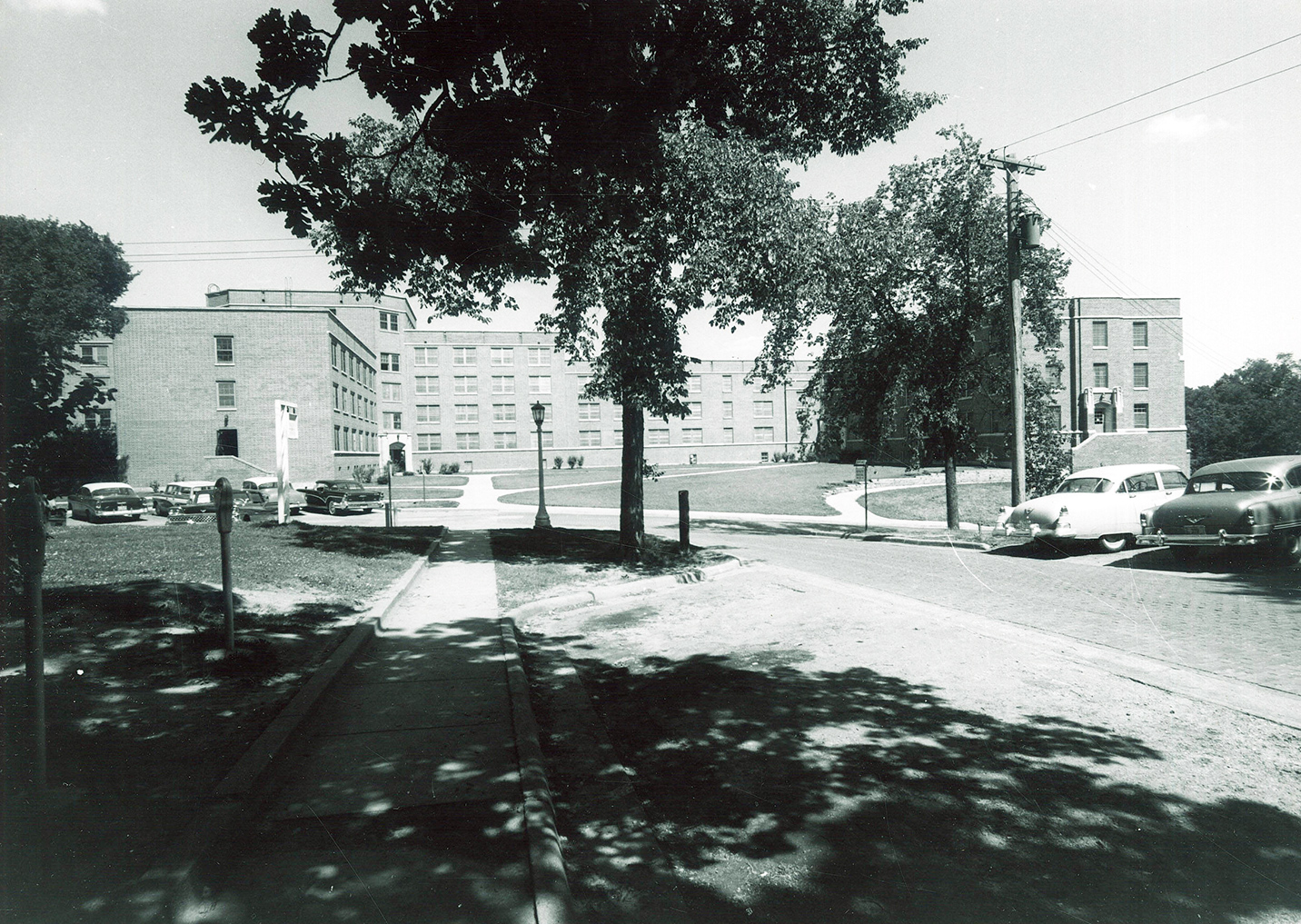
Hillcrest Residence Hall, where Robert Washington lived while in school, in 1960. University of Iowa Digital Collection.
At the time, blacks girded themselves against a looming sense that a racial incident could erupt at any moment. To minimize this was to deny the reality of being black not just in Iowa, but throughout much of the United States.
Fred Riddle, who is white and who played on the 1962-65 Iowa basketball team, recalled that in 1963, “We were playing Kentucky in Lexington, and we had a black guy on our team, Andy Hankins, and someone in the arena saw him and threw a cherry bomb on the court. It left a three-foot circle burned into the court. This wasn’t about Iowa playing Kentucky; it was that we had a black guy on our team. That night, we went to a restaurant and the waiter took everyone’s order, but stopped at Andy and said he couldn’t take his. That kind of behavior takes its toll. It affects you. It has to.”
Townsend recalled the rules he lived by in Iowa City at the time. “If I saw a group of white guys, I’d be reluctant to say anything to them. You didn’t know what to expect. It was one thing to play football with white guys, but it was another to see them downtown with their girlfriends. You were best friends on the field, but off, they’d just ignore you. Guys a couple of hours ago you’d be running blocks for, catching passes from, joking with, and suddenly they acted like they didn’t know you.”
So, Townsend said, “We had house parties and hung out by ourselves. If you went to the bars, you went at your own risk. We always stuck together. We were afraid of what would happen if we didn’t.”
After the Cavanaugh murder, blacks in Iowa City had to reconcile a series of conflicting emotions in the wake of Washington’s guilty plea. They were elated that Washington’s life had been spared, but many were scared. “We were concerned about our safety,” recalls Townsend. “Think about it: A black man kills a white man, cuts a deal, and may end up serving only 14 years for it? We didn’t know what was going to happen to us when whites fully digested that.”
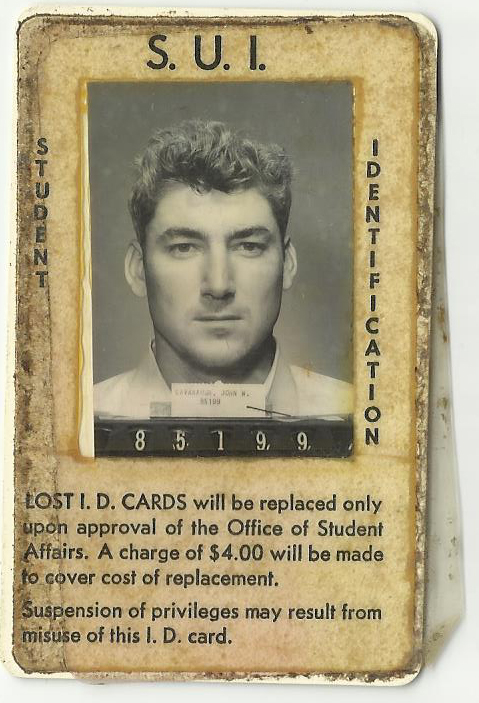
Cavanaugh's student ID.
Bobby Washington and John Cavanaugh were two ordinary American men whose paths happened to cross on an airless August day in an Iowa bar that today no longer exists. Except for their color, they shared more similarities than either likely would have cared to admit. Both were born in rural outposts of America, both had been students at the same university, both had worn military uniforms, both were living in a university town well after their prime. Both liked to hang out in bars and hold court. Both used to be somebodies: Washington a Big Ten athlete, Cavanaugh a Marine. When their paths fatally crossed, neither had much to show for what he had accomplished.
Going back further, much further, each had ancestors who came to America from lands far away, crossing the same wide, gray ocean, with terrible longings and wild dreams. Both were part of the greatest Diaspora the world has ever known. Both had pedigrees thoroughly American. Cavanaugh’s paternal grandfather was born in Ireland, emigrated during the wake of the Great Famine, landing in Boston, then lighting out for the land-in-the-middle, the Upper Plains, that part of America known for its fertile soil in which anything would grow. Washington’s people never passed through Immigration turnstiles; they were bound for auctions to be sold for however much their muscles promised.
The murder of John Cavanaugh took place at a turning point in American history, three seconds in the long bumpy road of race relations in this country. The staccato gunshots that discharged from the pistol Washington fired pointblank 50 years ago echoed an era of rancorous divide between whites and blacks in America. Cavanaugh’s murder underscored that racial divide: two counterpoints of America—one beginning to recede in power, the other stirring to ascend. Neither Washington nor Cavanaugh likely perceived either vector, but the emergence of that inexorable power shift on some level had to affect both men.
Like all blacks of his generation, Washington's life had been pockmarked by a profusion of racial incidents, including but certainly not limited to his grandmother’s tutorial about the lynching of her cousin, the Hawkeyes’ road trip to Dallas, the Yankee pot roast non-offering at that Oklahoma roadhouse, the knock-em-down black-white boxing match at Fort Bliss, his everyday life in Rockford and Iowa City. Cavanaugh, too, was a product of his environment, in Lohrville, Marine platoons in San Diego, South Korea, Pittsburgh, Waukegan, and his life in Iowa City. The combination of everything these two men brought with them to Li’l Bill’s at precisely the same moment was like lighting a match to tinder that combusted instantly.
All images featured above from the Library of Congress Digital Collection.
With the backdrop of a national tableau of Barry Goldwater and Lyndon Johnson running for President that summer of 1964, and the dawning of race riots in Harlem, Bedford-Stuyvesant Brooklyn, Dixmoor, Illinois (a black suburb of Chicago), Rochester, Jersey City, Philadelphia, and a year later in Watts, racial disharmony was no longer just simmering in America. It had detonated. Officially, it was called many things—the Race Problem, New Negro Militancy, Negro Movement, Race-Relations Revolution, the Struggle for Equality. Whatever it was exactly, the coming of something was sending shockwaves throughout white America with a combination of anxiety, fear and trepidation.
America’s broad middle swath was no exception. Fanning fear of mostly white readers, The Cedar Rapids Gazette, the largest paper near Iowa City and the second-largest in the state, ran inflammatory headlines such as “Negroes in Mass Orgy of Looting.” Rural America had little experience with blacks, let alone a national campaign allowing them to sit at the same table with whites.
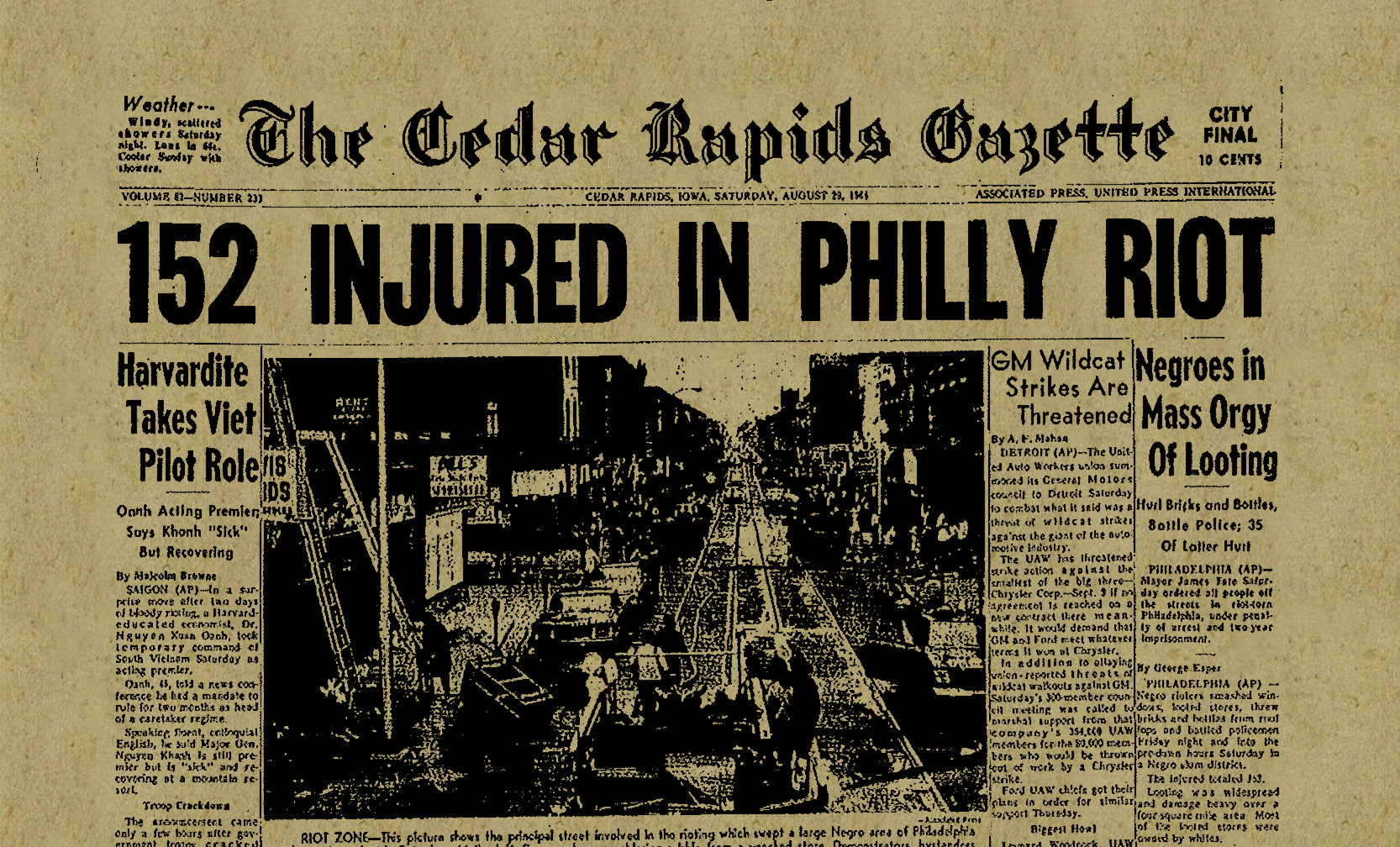
The nation had been divided long before Martin Luther King, Jr. delivered his “I Have a Dream” speech the previous summer, and a year later the chasm separating White and Black America had widened to an abyss. Add to the national timeline, black student James Meredith, who had been barred from the University of Mississippi until his admission was forced by the Justice Department in 1962. Meredith endured students living above him in an Ole Miss’ dorm, bouncing basketballs on the floor all night long; when he showed up in the cafeteria, students on cue turned their backs.
In 1963, a black dentist in St. Augustine, Florida, Robert B. Hayling, led “wade-ins” at the city’s segregated swimming pools, which prompted KKK marches in the city, as well as death threats against civil rights activists. Hayling responded, saying, "I and the others have armed. We will shoot first and answer questions later. We are not going to die like Medgar Evers,” the civil rights leader who had been killed by white extremists the previous June.
Six weeks before Washington shot Cavanaugh, three civil rights workers, James Earl Chaney, Andrew Goodman, and Michael "Mickey" Schwermer, were shot at close range and killed by Klan members in Mississippi. Their bodies were found four days before Washington was to appear in Johnson County District Court to enter a guilty plea for Cavanaugh’s murder.

Monson Motor Lodge manager James Brock pours muriatic acid into the whites-only pool to get the protesters out during the summer of 1964 in St. Augustine, Fla.
Two months before Cavanaugh taunted Washington with the racial epithet in Iowa City, in St. Augustine, Florida, a motel owner poured muriatic acid into the motel’s whites-only pool, at the time filled with protestors. The Civil Rights Act of 1964 was signed into law two weeks before the Cavanaugh murder.
The national racial turmoil of 1964 helps set the scene for that stifling August day when blustery John Cavanaugh walked from the Union Hall to Li’l Bill’s in search of Bobby Washington, underemployed in a factory job. In the process, Washington and Cavanaugh unwittingly became bit players in the multi-stage drama engulfing America.
Trying to place into context the killing of one human being by another can be offensive, particularly to the victim’s family and friends. Attempting to understand motives can be tantamount to justifying them. The dead have no voice; they can't explain their side.
Why couldn’t Washington have done what nearly everyone would have done that day? Not to bother with Cavanaugh. To ignore him. To flip him off. To get into a fistfight. Who kills someone for hurling an insult, even if it is a racial slur?
Ultimately, though, an unthinkable question arises: Could Washington — who he was, where he found himself, the totality of his life experiences, his persona as a backdrop to the nation’s spiraling racial mayhem — have gotten away with not reacting that day?
The problem, of course, was how he reacted, with a gun. If these two men had taken swings at each other, brawled on the barroom floor, to be broken up by Red, Paul Coty and the others in Li’l Bill’s that day, then those deadly three seconds never would have ticked so loudly in both men’s lives. Two men’s lives briefly interrupted, then resumed. A moment muted with time, hardly to be recalled a half-century later.
But considering its context within the national drama at the time, what Washington did on that humid day was what not just a few other angry black men at the time might also have considered, even though common sense ought to have ruled it out in an instant. This is neither apologia nor rationale.
To underscore the potential of racial conflict and how intimidating it must have been at the time in Iowa, look at this, the seven-word, sixth paragraph of the banner-headlined story in The Cedar Rapids Gazette the day after the killing: “Cavanaugh is white. Washington is a Negro.” Yet in the same story, the local police chief was quoted as saying, “There was no evidence that the argument between the two men concerned the race question.”
Then why the mention of the race of the suspect and the victim?
In fact, everything about the killing had to do with race.
Washington was no Rosa Parks. At that time, he didn’t have the maturity and temperament to shake his head and hold his ground. There were no organizers coaching Washington on how to comport himself that day. The way Speedy Townsend sees it was that Washington “made a poor choice.” But Townsend said, Washington “was person of principle. He was willing to suffer the consequences for his actions.”
Washington said at the time that to atone for the murder he understood that he had to serve time in prison. “I got what I deserved. Someone died at my hands. I accepted it as my cross to bear.”
In an instant, the man who once thought himself a budding philosopher postulated a basic tenet of Cartesian Natural Law—that man is responsible for his actions and ought to accrue or suffer appropriate consequences for the exercise of such actions. Pure Descartes. No schism exists between mind and body.
In thinking back on the turns of his life, Washington acknowledges that his compact stature and competitive nature served him for good and for bad. “All my life, I’d been the best athlete in whatever group I was in. I was spoiled by that. But being small, everything I got I had to fight for. I hated to lose. I still hate to lose.”
At that low point in his promising life, Washington already had seemed to have lost. The beers he and Harold Poggenpohl drank that morning might have clarified how far he had fallen. Seeing swaggering Cavanaugh, hearing Cavanaugh taunt him so brazenly and so publically, Washington told me almost 50 years after the murder, “I’m not sure I could have walked away from that. I did what I thought I was supposed to do.”
Washington has never talked to Cavanaugh’s family. “I said I was sorry when I was sentenced. I did my time. Isn’t that enough?”
As I looked at Washington when he told me that, I noticed his jaw tightening. For a second or two, I imagined his thinking was what the murder had done to him and to his life, but Washington's own code is not to speculate on what could have been. A man died at his hands. If all his years at Fort Madison taught him anything, it was that such conjecture doesn't go very far in the real world.
In 1952, the French photographer Henri Cartier-Bresson coined an expression, the decisive moment, to describe a human instant of pivotal significance. The decisive moment is a split-second that Cartier-Bresson captured in thousands of his iconic photographs. Cartier-Bresson wrote that his photographs “depict the content of some event which is in the process of unfolding.”
In our own daily lives, few such moments are ever recorded. Few are even noticed. Certainly, those three seconds in Li’l Bills were a decisive moment—absolutely for Cavanaugh, surely for Washington, too. When a random sequence of events makes for a happy outcome, we call it serendipity. When the haphazard chain mutates, we refer to it as bad luck, bad timing, bad shit. The Scottish writer William Boyd coined a word to signify the opposite of serendipity: zemblanity.
“Bobby was a very good student in high school. He could have been a CPA if he had worked at it. He also could have been a professional baseball player. I’m convinced of that. He was that good.”
If Cavanaugh had overslept that morning, if Washington had shot hoops, if the clip in the pistol Washington borrowed from his roommate had jammed—if thousands of interlocking events hadn’t lined up exactly right (or wrong), who knows how each man’s life would have played out. Zemblanity in action. The perfect storm. No one knows what either Washington or Cavanaugh could have become, what each would have gone on to accomplish, how their lives may have profoundly and fundamentally changed the lives of hundreds, perhaps thousands, of others.
Washington’s oldest friend, Nolden Gentry reflected on those three seconds 50 years ago. “Bobby was a very good student in high school. He could have been a CPA if he had worked at it. He also could have been a professional baseball player. I’m convinced of that. He was that good.”
And John Cavanaugh? The last classes he took at the university were Advertising Management and Business Finance before his status as a student was canceled. He might have gone into business, returned to the Marines, no one knows. He would have been able to mentor four children to adulthood.
Cavanaugh’s brother, Joe, the man who believed that after his stint in the Marines Cavanaugh came back “vulgar and crude,” conceded that Cavanaugh’s full-throttle personality sooner or later would have gotten himself into a situation that could have escalated into violence.
The way Nancy Cavanaugh’s brother, Bob, said he believes the murder unfolded in this way: Cavanaugh came looking for Washington at Li’l Bills and put his hand on Washington’s shoulder, just to acknowledge his presence, merely to inquire what Washington wanted.
But Cavanaugh’s stratospheric blood-alcohol level likely mitigates this interpretation, along with Cavanaugh’s reputation as a bar brawler, and tavern owner Paul Wilson’s insistence on escorting him out of Li’l Bill’s.
Perhaps there was no ill intent. Maybe all Cavanaugh wanted to do was apologize. Talk about jobs Washington might apply for at the Union Hall. Perhaps because Cavanaugh’s wife and children had left town earlier that week, he just found himself on a Saturday afternoon in August without much to do.
San Bernardino
California
Four months after the murder, Nancy Cavanaugh and her four children boarded the Rocky Mountain Rocket at the Iowa City train depot, and rode the train all the way to Los Angeles to visit Nancy’s brother in Canoga Park, in the San Fernando Valley. Nancy eventually would say she hated snow, that she never wanted to see it again. Southern California would become their new home. She swore that she would leave Iowa for good. No way were she and her young children going to be there for the first-year anniversary of the murder. The University of Iowa College of Education had awarded her a master’s degree in elementary education in the summer of 1965, and she promptly secured a teaching position at Rio Vista Elementary School in San Bernardino for the fall. In August, she piled her children into a brand new, gold-colored Chevrolet Impala and pointed it west. She never was to return to Iowa.
Nancy Cavanaugh rented an 1,800-square-foot ranch house at 3917 Del Ray Drive in San Bernardino, and with savings from her teacher’s salary, she was able to put a down payment on the home and within three years buy it. Kevin and Karen had their own bedrooms, and the two younger girls, Kelly and Kathy, shared another. San Bernardino, these days known as the capital of Southern California’s Inland Empire, was safe and teeming with children. San Bernardino was the American Dream gone West.
Nancy liked to say San Bernardino was the best babysitter in the world for her four kids. The pastoral neighborhood was filled with prickly thorns, sagebrush, and tumbleweeds, an ideal place to play for young budding cowboys and cowgirls. A nearby wash, or flood-control area, provided endless adventure. A creek ran through the middle of it, and Kevin Cavanaugh remembers catching toads, lizards, and snakes. Rabbits used to build tunnels in the sagebrush and he’d crawl through them with his friends, sometimes even with his sisters. The 100-degree Southern California summers convinced Nancy to install a swimming pool in the backyard. The Cavanaugh siblings suddenly became the most popular kids in the neighborhood.
Nancy Cavanaugh never remarried. She took upholstering classes and maintained a never-ending series of half-finished projects in a corner of the living room. An early riser, she never missed a day reading the San Bernardino Sun, and drank a whole pot of black coffee before going off to teach. She smoked like a chimney (switching from Chesterfield Kings to generic menthols), and she loved to shop. She favored cream-colored slacks and adored Lucille Ball. Kevin, the oldest child, occasionally was able to coax his mother into letting him stay up to watch with her Johnny Carson on The Tonight Show. Nancy liked detective dramas; Mannix and Kojak were her favorites. Every week without fail, Kevin and his mother would watch The High Chaparral together.
Years earlier, she and John Cavanaugh used to go regularly to St. Patrick Church, around the corner from their Iowa City home, but after the murder, Nancy rarely set foot in a church. After more than two decades of teaching, she retired, and on November 1, 2001, at age 78, she died of lung cancer.
John Cavanaugh’s father, Mark, the man who without fail every day ate three eggs and six strips of bacon, died in 1971. All but one of Cavanaugh’s brothers and sisters are now dead. Cavanaugh’s older brother, Jerry, became a chef in California, his younger brother, Joe, a dentist in Perry, Iowa, his sisters nurses and teachers. I tracked down the only remaining sibling, Charlotte Cavanaugh Heinrich, a retired nurse who lives in Carroll, Iowa. At the time of her brother’s murder, she was 22, caring for a newborn baby, pregnant with a second child.
“A relative came to the door of our apartment and told me. I was devastated. I couldn’t believe my ears. We all adored John. It was very hard on my dad and family,” Mrs. Heinrich, 77, recalled when I contacted her last spring. “He was a great guy. He had a terrific personality.”
Mrs. Heinrich allowed that, “John liked to drink. But as far as I knew, it wasn’t a problem.” She characterized her brother as “a big guy. He was muscular, but he had just gotten out of the Marines, and they work them hard.”
I asked her what she would say to his killer should she have the opportunity. “I forgive him,” she responded immediately, her voice weak, the result of the chemotherapy she had recently undergone due to lymphoma. “It was a terrible thing. I’m not prejudiced against colored people. I know he was sorry for what he did. I forgive him because it was a lot of years ago. He was young himself. He’s had a lot of years to think back on what he did. My father believed in forgiveness, and so do I.”
One of the Cavanaugh children, Kathy, died in 2009 at age 47 during an operation to remove part of her pancreas. The three others are alive. Kevin, the oldest at 58, was a lecturer in mathematics at San Diego State University for 13 years until he was forced to retire, a casualty of state-mandated attrition. He now works at Costco.
“I’d kinda like to see him, but I wouldn’t want to meet him. I’d like to hear his side of the story. That’s what I’d want to do.” — Kevin Cavanaugh, speaking about Robert Washington
“Who knows? My dad might have been a brute. But I remember him as positive and happy. He never lifted a hand on me. I remember hugging him. I remember him walking me on the ceiling, upside down, holding me, and I remember wrestling with him. I do know he was a strong guy. My Uncle Jerry said he could rip a phonebook in half,” Cavanaugh said.
After the murder, Kevin was to take on many of the responsibilities that would have fallen to his father. “My sister, Karen, used to call me MOTH, ‘man of the house,’ and I guess that was right.”
John Cavanaugh today would have had seven grandchildren and four great grandchildren. He would have been 84.
Cavanaugh traveled to Lohrville, Iowa, where the graves of his parents’ firstborn son, Jeffrey, the brother Kevin never knew, and Kevin’s father, John, are located. Kevin sprinkled his mother’s ashes over both plots.
About Bobby Washington, the man whom Kevin Cavanaugh as an eight year old used to fantasize sneaking into the Johnson County Jail and stabbing, Kevin said he’s curious. “I’d kinda like to see him, but I wouldn’t want to meet him. I’d like to hear his side of the story. That’s what I’d want to do.”
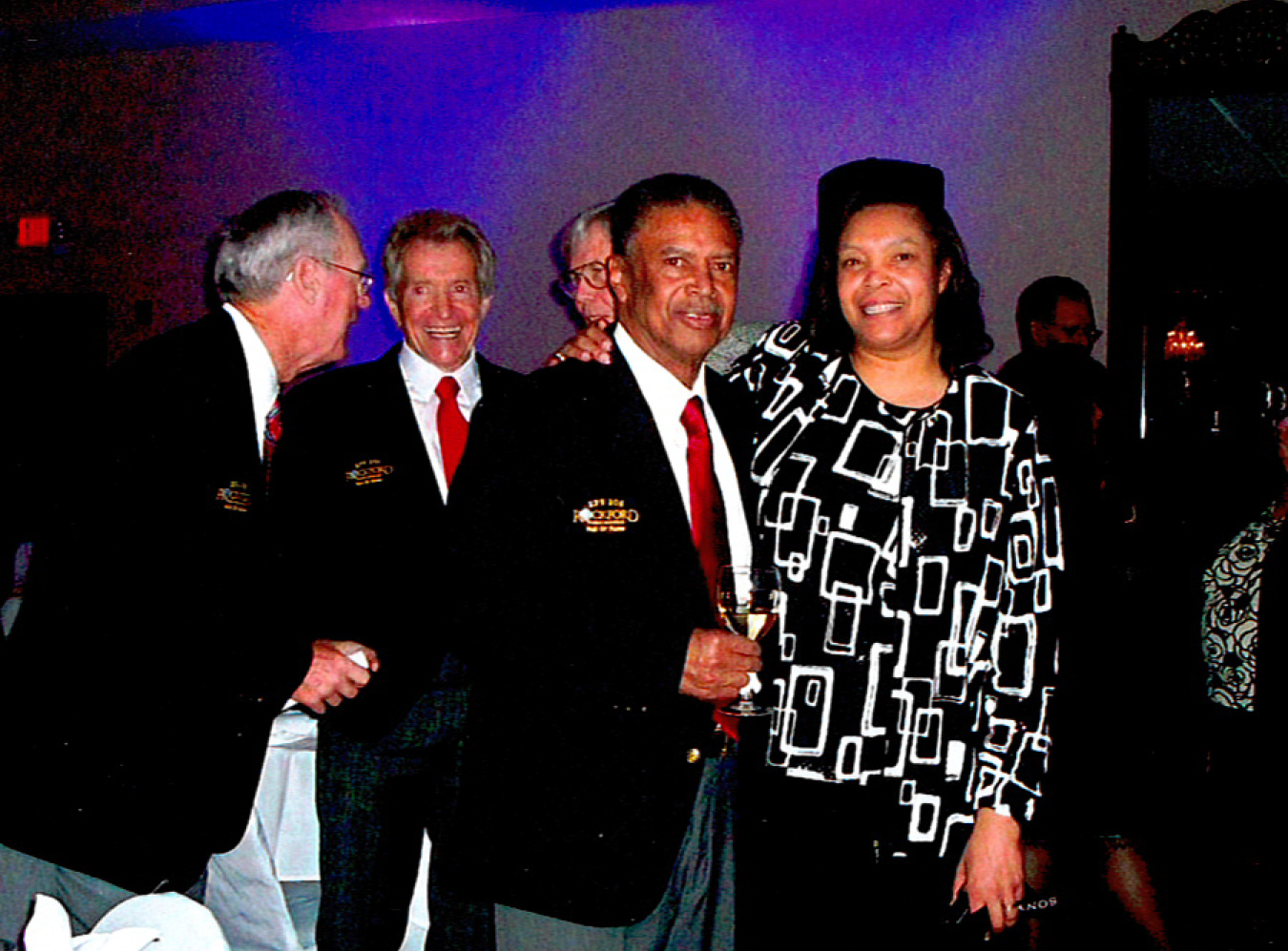
Induction into Rockford Public School's Athletic Hall Of Fame, Washington and his wife, Tamarra, 2013.
Four years ago, 46 years to the day after the murder that ended John Cavanaugh’s life and so defined Robert Washington’s, Washington and I drove to the Iowa State Penitentiary at Fort Madison. He had never left Iowa, and still lives not far from the prison. In 1983, Washington married a woman from Burlington, Tamarra, whom he met on a blind date. Both are retired. At 78, Washington is still athletic and plays golf as much as he can. He's a near-scratch player.
This was the first time Washington had returned to the prison since he had left 13 years earlier. (Today, the prison is in a state of shutdown; construction of a new high-tech $132 million penitentiary three miles away has been completed, but problems with the heating and cooling systems have delayed the facility’s opening.)
Washington had on dark-blue trousers, a pressed white dress shirt, and newly polished shiny lace-ups. He had dressed up for the visit. As we walked into the visitors’ area, there were surprisingly few preliminaries: going through the metal detector, swapping our driver’s licenses for temporary prison badges. Getting in was easy.
We met the warden, Nick Ludwick, who’d been at Fort Madison for just two months. He was big, maybe 250 pounds, with broad square shoulders. His gut was girded by a thick leather belt, his shaved head had a sheen and was topped with a pair of black wraparound sunglasses. Ludwick resembled a beefed-up version of Dean Norris, the actor who played DEA Agent Hank Schrader in Breaking Bad.
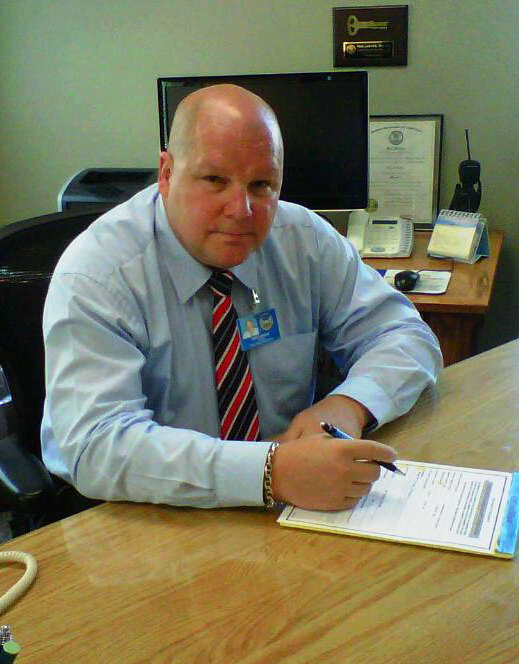
Warden Nick Ludwick. Image Courtesy of Iowa Department of Corrections
Ludwick had heard of Washington, and I sensed he’d been looking forward to meeting him. For his part, Washington seemed ill at ease. He fidgeted as we sat on the prison-made Naugahyde furniture.
Ludwick’s a talkative guy, and he took over right away, perhaps recognizing Washington’s discomfort about being back in the big house. Ludwick had spent 30 years in various jobs in the Michigan State correctional system and was new to Iowa. His wife still lived in Michigan, and because of that, he’d been commuting on weekends via Amtrak from Detroit, through Chicago, down to Fort Madison. His job as prison strongman came up, and we immediately got into what it means to be a tough motha.
“This weekend, I'm on the train, and I have a reserved seat. When I get to my seat, there’s this guy sittin’ in it. So, I say, ‘Please move.’ Nice and easy. And this dude doesn’t even look up. All he says is, ‘Pick another seat.’ I can’t believe this asshole, so I say it again. ‘Please move.’ And he tells me, ‘Pick another seat.’ But this time with an edge. People in the car are startin’ to look at us.
“‘Look, asshole,’ I say. ‘I have hamburger meat in my refrigerator tougher than you. I’m telling you to move. What don’t you git about that?’
“Everyone’s looking at us, not knowing what’s gonna happen. No one says a word. We got a standoff goin’. And then this dude gets up and moves to another seat. Just like that. And as he’s leaving, the circle of people watching us applauds. It made me feel good.”
Whatever Ludwick's motive, the story worked. Washington stretched his legs and started in with a little of his own, about surviving on both sides of the prison walls.
“I like you guys,” said Ludwick out of nowhere. “I heard a lot about Bobby, and I like what I’m seein’. I like how you handle yourself.”
I could see Washington was trying to assay where he was, what it meant, trying to get comfortable, into position. To Washington, Ludwick was still the warden, the man.
“You wanna do the joint now?” Ludwick suddenly asked.
We went through a series of metal gates. As we proceeded through one, the gates behind us closed shut as we stood in a holding area, waiting until another series of gates opened, gate after gate, door after door, until we arrived at one end of the Yard. Ludwick seemed to relish what lay ahead. “I tell prisoners, ‘Put your arms out,’ and when they ask me why, I say, ‘Cause if yours are longer than mine, then we gonna have a whole lotta trouble.’”
We were walking the Yard’s veined concrete slabs, the colossal fortress' impossibly tall, thick walls blotting out everything beyond their perimeter. The only exit was the cloudless azure sky. It was difficult keeping up with Ludwick, who was practically jogging, but I could see Washington was thinking, temples pounding, conjuring up images, smells, a lifetime within these walls.
Near one side of the Yard, we faced two dozen fenced-in cages of 15- by 20-feet, and as we got closer, in each was an inmate. “We call them exercise modules, but they’re dog runs,” Ludwick said, offering no apology. “What else can you call them?” In each pen was a splintered, slanted wood exercise bench and nothing else. Inmates deemed violent to other inmates, or whose welfare would be compromised if placed in the general prison population, were confined in these enclosures. They were as primitive as it gets, down several rungs from Gitmo.

A cell at Fort Madison. Image Courtesy of Iowa Department of Corrections.
Washington up to now hadn’t said much. But as we walked into Cellhouse 319, where older lifers were confined, I could see his eyes darting, his head bobbing, trying to anticipate what lay around the corner. He wasn’t sure what reaction he’d get.
Washington nodded to several guards, the reaction muted, from both Washington and the correctional officers. There was a sudden chill. After all these years, I could see that Washington’s heart was squarely with the inmates, not with the men who controlled them, the men who once controlled Washington.
Two inmates shuffled by us, shoulders stooped. Both had bodies wracked with arthritis. They had either badly fitting dentures or no teeth at all, I wasn’t sure which.
“Bobby! Bobby Washington! Can’t believe mah eyes,” piped up one of the men, a prisoner by the name of Gentric Hicks, who looked to be in his late 70s, serving a life sentence for first-degree murder. He came towards us. “How long it been? Ten years, 15? You lookin' gooooood, Bobby!”
“I’m doin’ all right for myself,” Washington said almost shyly.
Soon, two more inmates came up to us. “Bobby, dat you? Haven’t seen you for a loooooong, loooooong time. Life agreein’ wit’ you, I can see dat!”
Washington nodded. He shook hands with the men. They eyed each other for a second, then moved in closer, now full smiles on each, finally embracing.
That’s how it was for the next two hours. Wherever we went, groups of inmates approached Washington. You could see the goodwill between them and Washington, and with more than a few, an absolute, sheer happiness upon seeing Washington step back in their lives for this wholly unexpected and sublime moment.
Bobby had gotten himself out. He’d made something of himself.
Suddenly, the shrill prison whistle blew, breaking any sense of reverie these encounters had created. As we made our way through the exercise area in the Yard, buff black inmates were working out in the hot afternoon sun, impossibly bench pressing as much as 500 pounds. Smaller groups of whites worked out, too, but the free-weights area was controlled by blacks.
“Hey, warden, you got two minutes? I gotta see you about gettin’ my GED,” one inmate said to Ludwick, as another asked about getting new prescription glasses, another asked about ordering high-top sneakers, and another wondered why his two brothers couldn’t sit with him and his mother when she comes to visit.
I wanted to go with Washington to fish row, tier four, to the same cell where he was first housed at the penitentiary 50 years ago, back in 1964. Cellblock 217 had long been closed by federal court order, but Ludwick corralled a guard, who after some uncertainty, unlocked a metal door to the crumbling, empty prison building. We climbed up a steep claustrophobic stairwell, and walked to cell E-5.
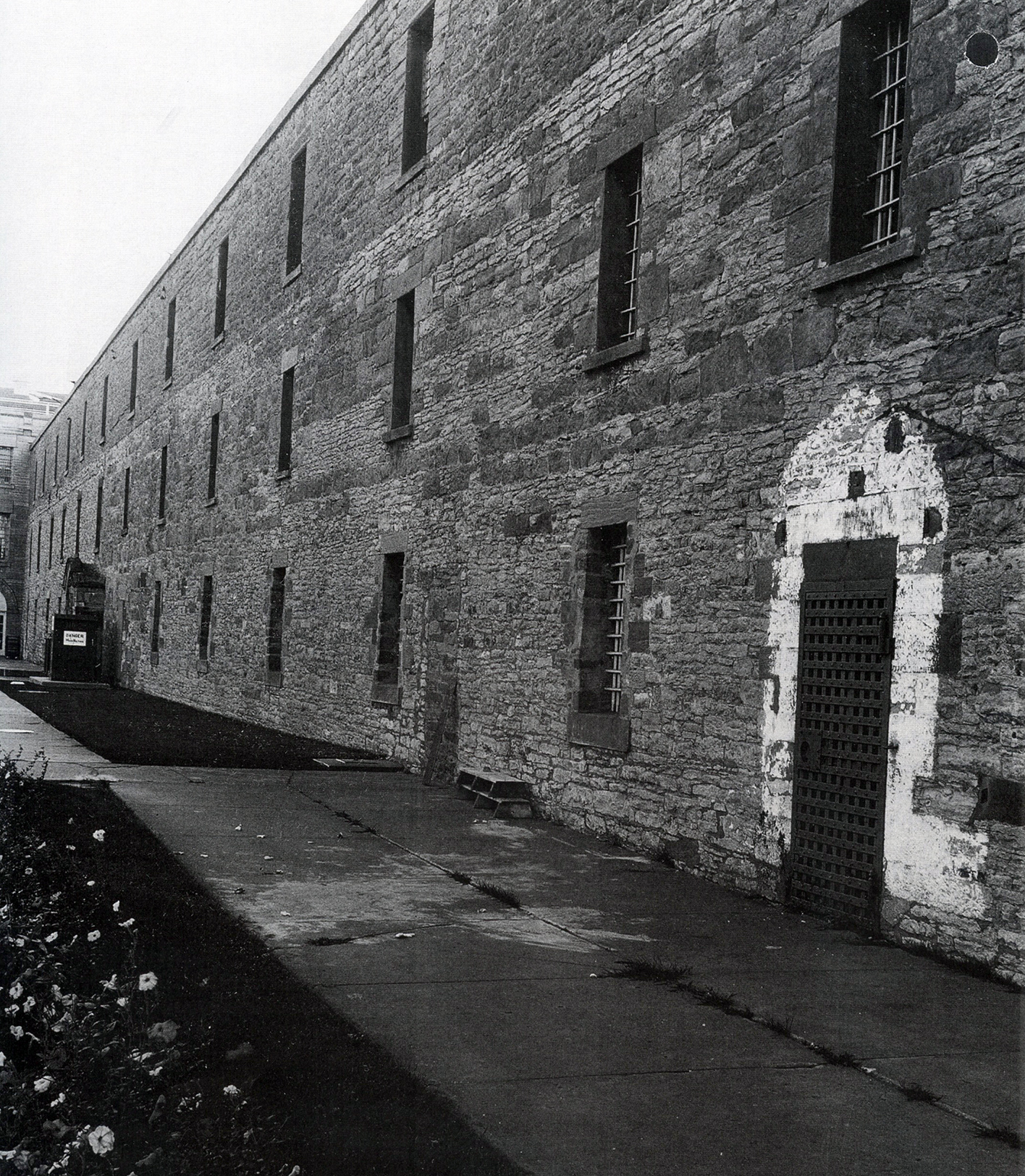
An exterior wall of a Fort Madison cellblock Image Courtesy of Iowa Department of Corrections.
While the cellhouse had been without prisoners for 25 years, it was perfectly preserved, a moment of time left undisturbed. E-5 was a tiny, six-by-eight cell, with a cracked, stained porcelain toilet and sink. With a cot and a small desk, there wasn’t room for much else. Any prisoner contemplating pacing back and forth would have to walk in place.
Washington went in, past the 14 bars with chipped beige paint, the green on the walls long ago peeled away. He paused. “I remember right outside here, when the guy next to me—that was John Kyle—took a wooden block he used for working on leather, and one day when he was leaving the cell, he threw that block to the cellhouse flag, hit who he was looking for, and paralyzed that guy.”
Washington shook his head. He seemed to be reflecting on how he ever could have survived, the violent behavior the cell conferred on its occupants, and ultimately where his life before and after had led him.
“I never put anything on the wall, just a calendar. I didn’t want anything else. I didn’t want to make it home. I wrote letters and read as many novels as I could get my hands on. It was so hot in here you just sat in your underwear, tryin’ to get through. Gettin’ through. That’s what you thought about.”
As he talked, I noticed how controlled Washington had become, how certain he once again had become of his place, knowing where he was, who was around him, who might close in on him.
He was silent. We stood in the cell, no more words. What else was there to say? It all was too cosmic, too risky.
Finally, we left the cell, and walked through gate after gate after gate, door after door, scores of them, each electronically controlled, each sliding open, then closing, each with an echoing finality. We exchanged our visitor’s badges for our driver’s licenses until were outside the prison walls.
The 50th anniversary of John Cavanaugh’s murder came and went last August with no fanfare. In a never-ending parade of Civil Rights milestones from the 1960s this half-century-old event didn't make the news. Except for a handful of people alive today, the killing has no relevance.
For Washington, the murder that changed his life is not something he spends time mulling over. The weekend following the anniversary, Washington told me, “It’s something that comes to me from time to time, and I wonder how my life would have turned out had the incident not occurred—or, at the least, had no one lost his life.”
Now in the twilight of his years, Washington doesn’t recant much about that day. “As for the victim's family, as part of my sentencing statement, I indicated my sorrow for my actions,” he wrote me in an email. “In that sense, I was, and am, hopeful his family could move on, as I and my life have.”
It came to me, once again, that during the entire five years of our conversations, Washington had never once mentioned the name of the man he had killed. Surely it was a coping mechanism, a way to dissociate himself from the impact of his actions so long ago.
As for Kevin Cavanaugh, the oldest child of John Cavanaugh, he doesn’t remember much of his father. After all, Kevin was eight at the time of the murder.
But unlocking a door that hadn’t been opened for decades had surely stirred his curiosity. “I was wondering how much time elapsed between when my dad entered the bar till he was shot,” Kevin text-messaged me.
“Maybe five minutes,” I wrote back. I felt callous writing that, but it probably wasn’t even that long.
I wasn’t sure why Kevin asked. Maybe he was hoping that his father and Washington had had something of a conversation before the encounter turned deadly. Maybe Kevin was hoping that if the two men had exchanged words other than threats, Washington today would be able to recall something sympathetic about the man he killed.
I asked Kevin whether he did anything to mark the event that had so fundamentally changed his life.
He said at the exact moment of his father’s death a half century later, he paused and choked up. “I was at work, and at 10:55 my time, I was thinking he was confronting Washington.
“And by 11, I was thinking he was dead.”


